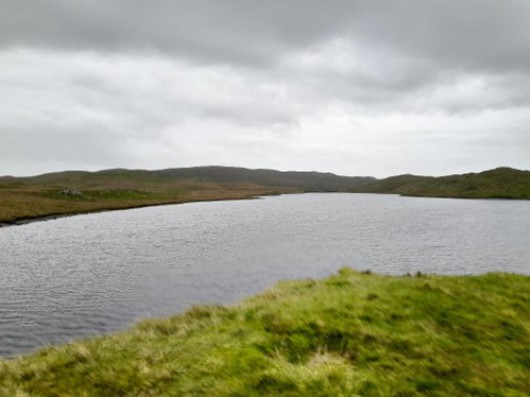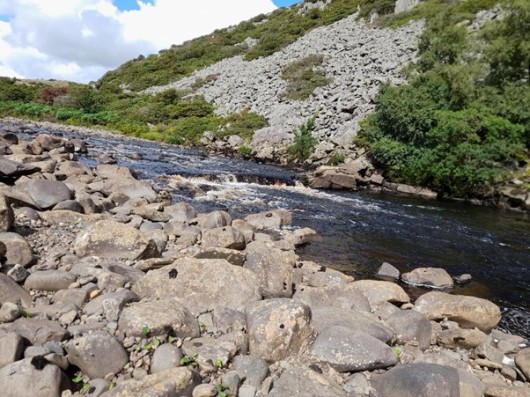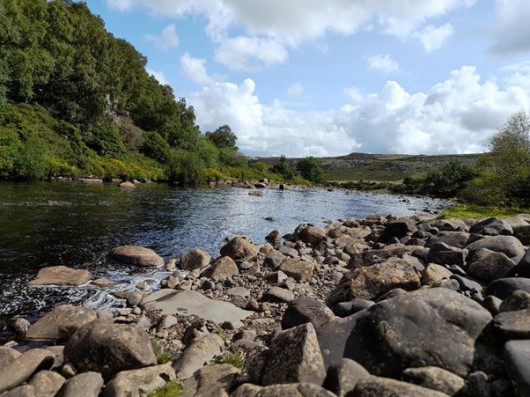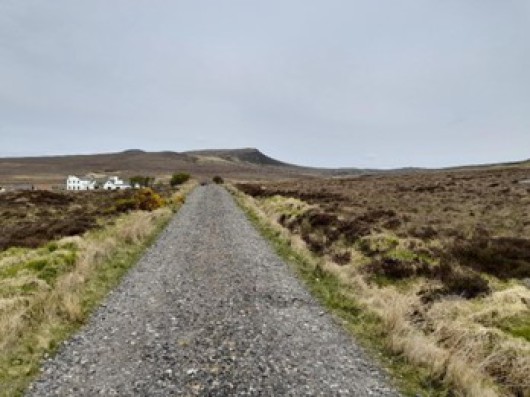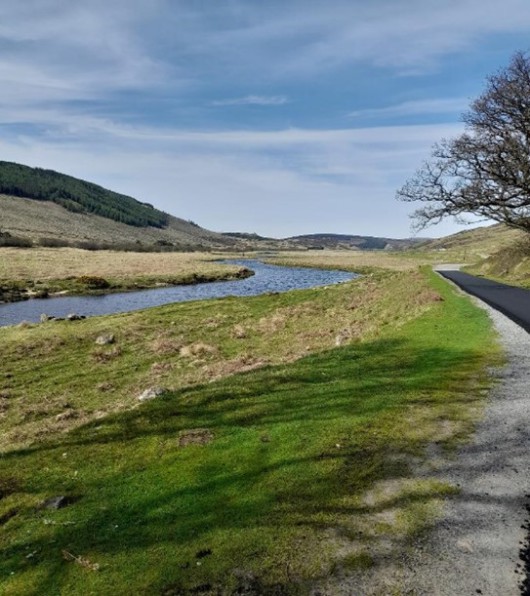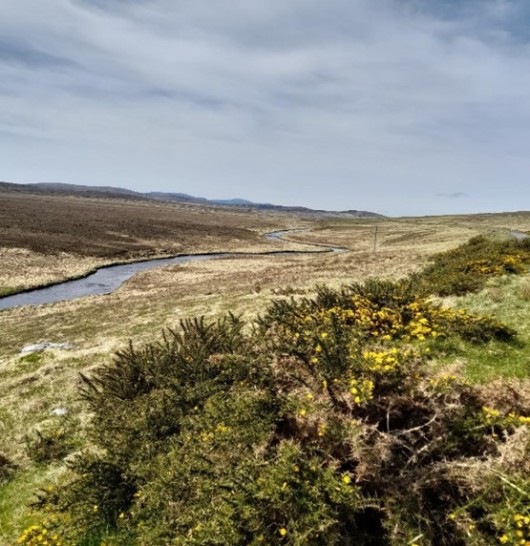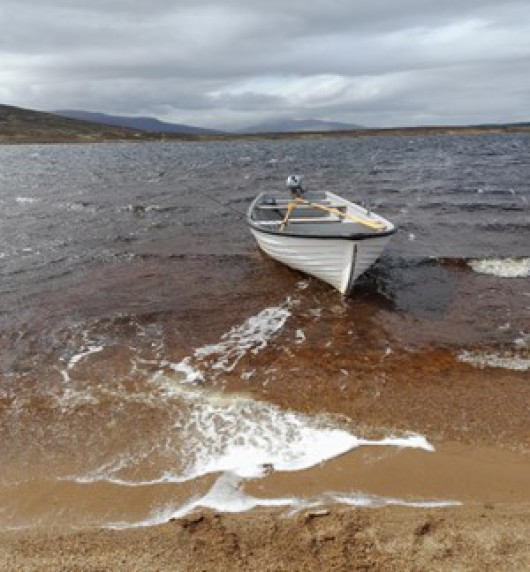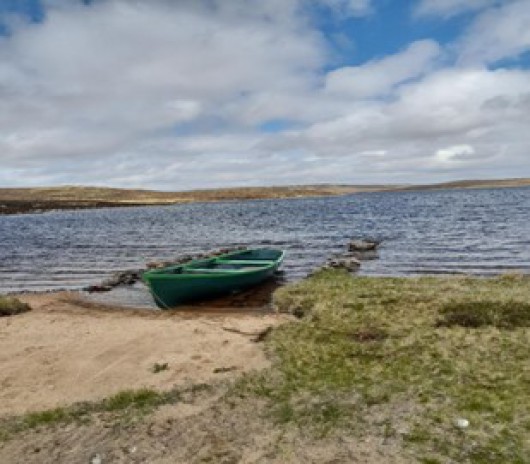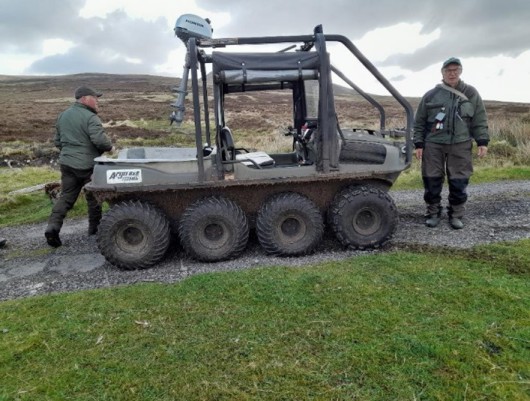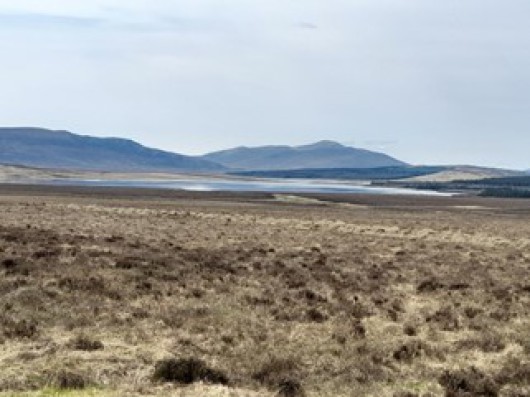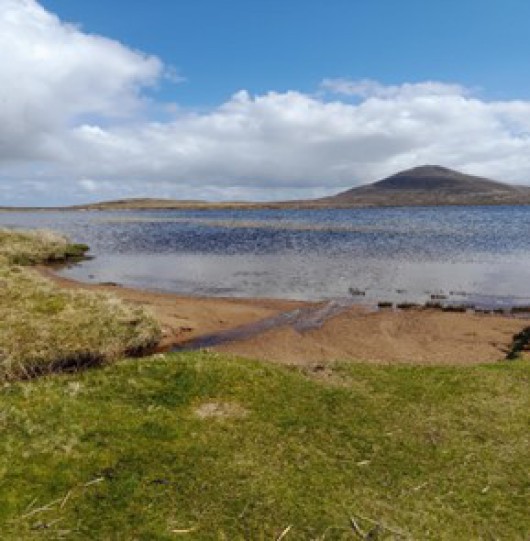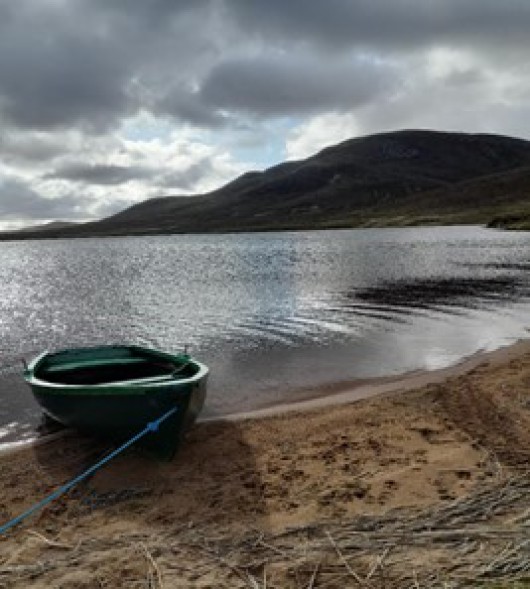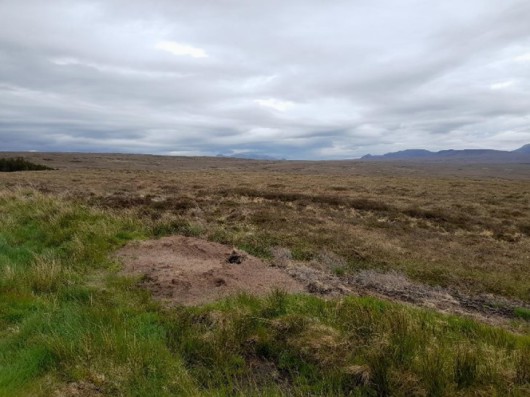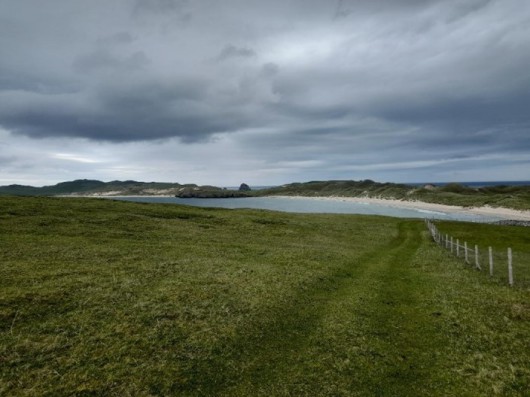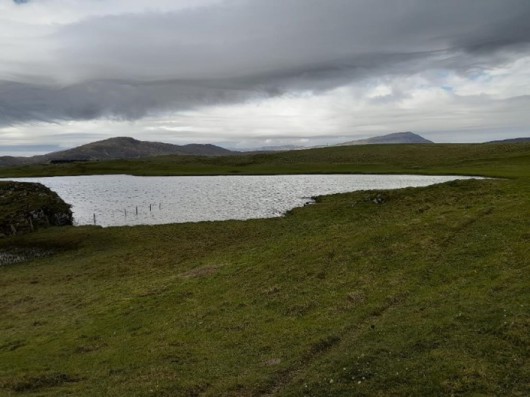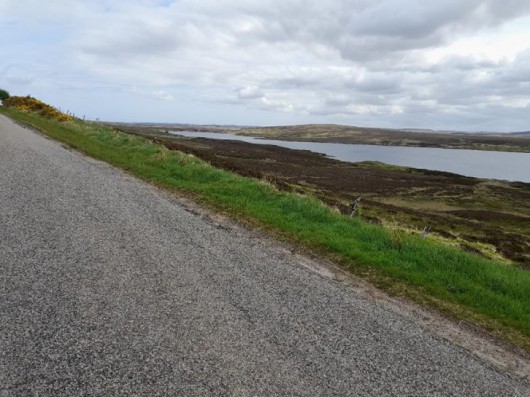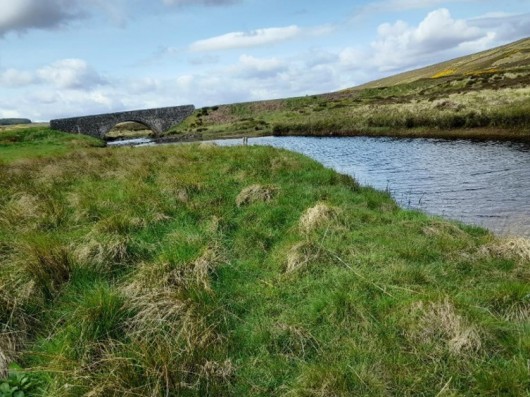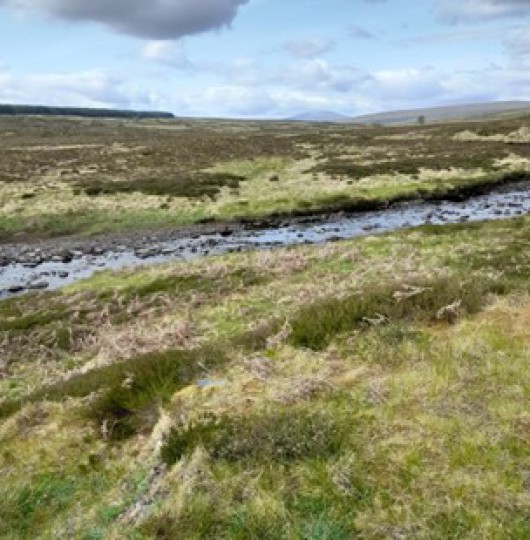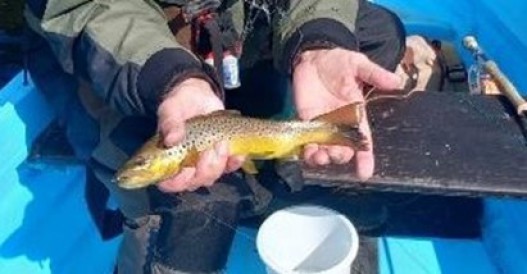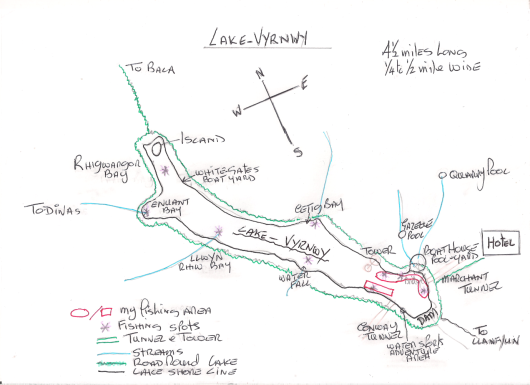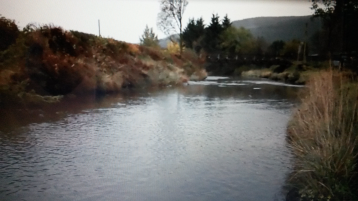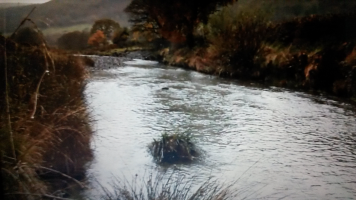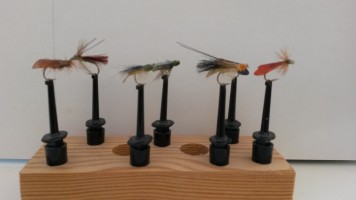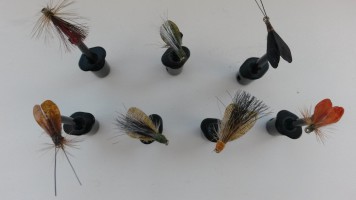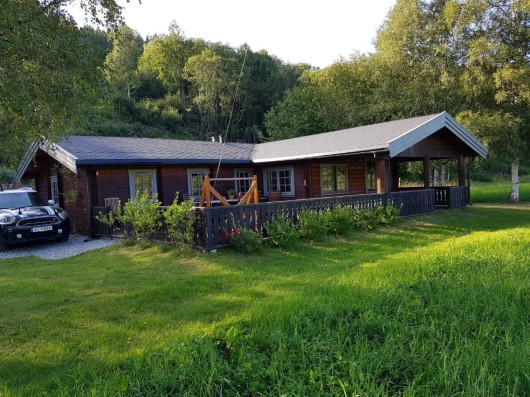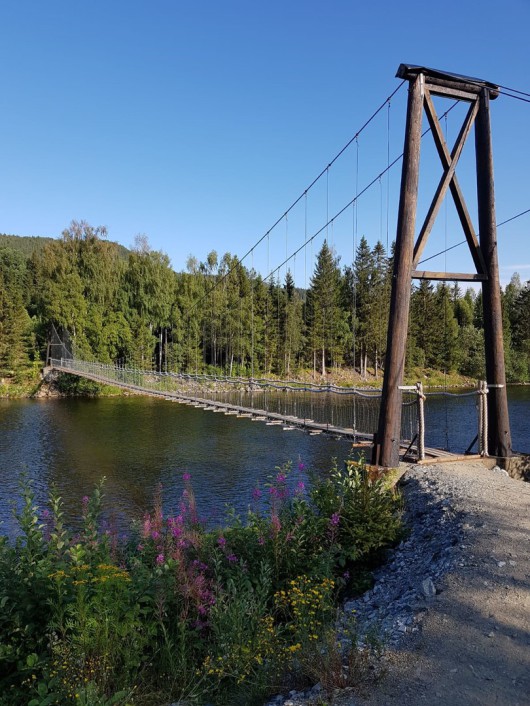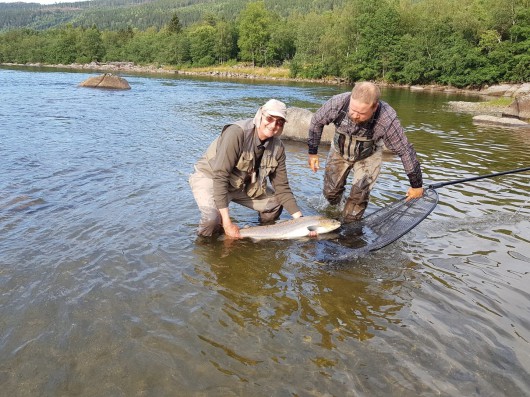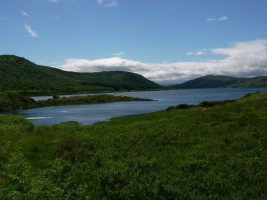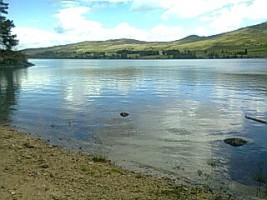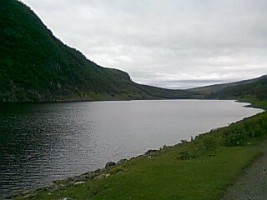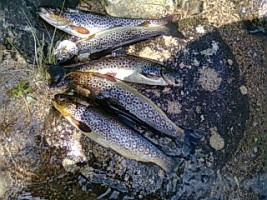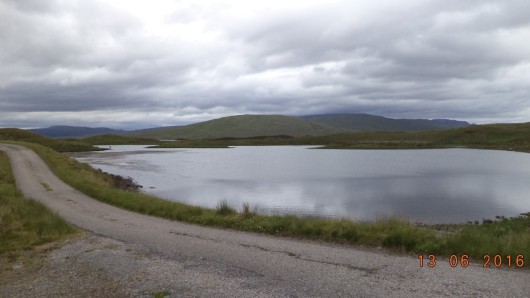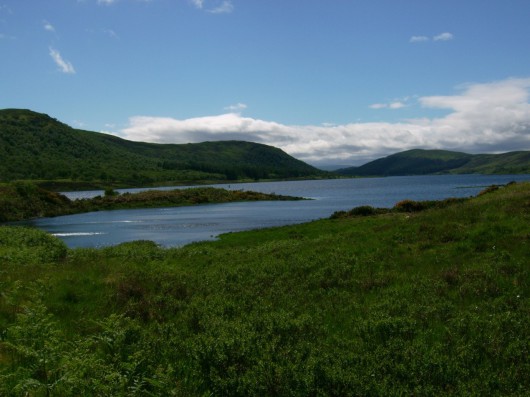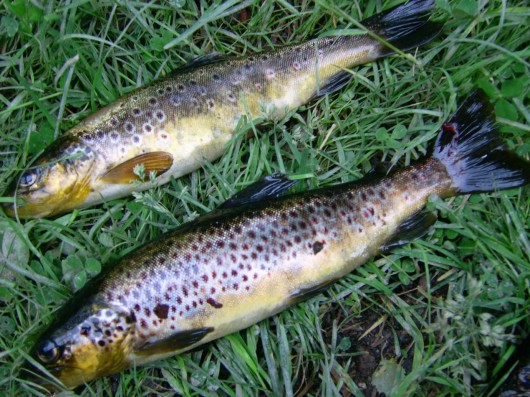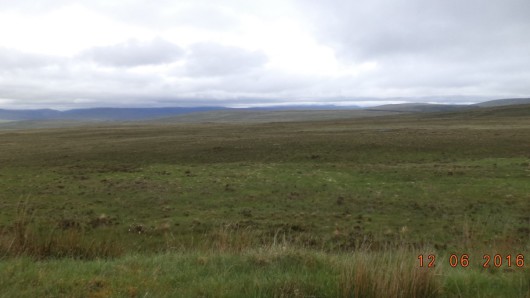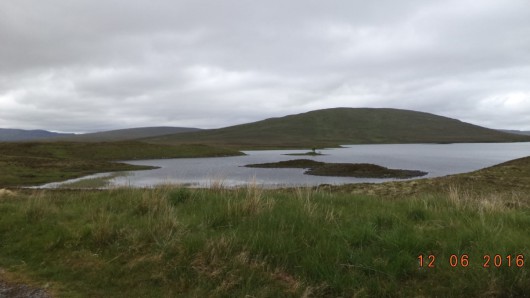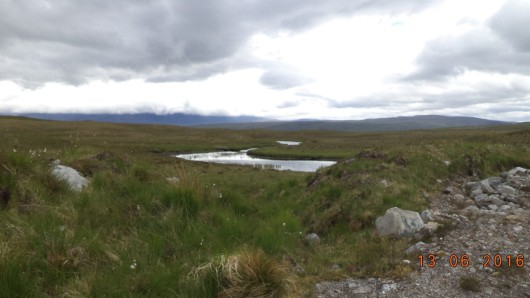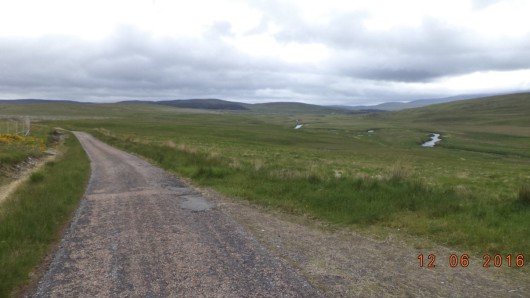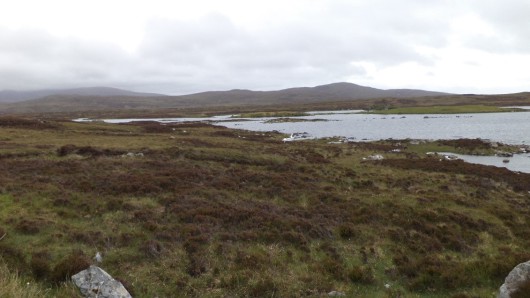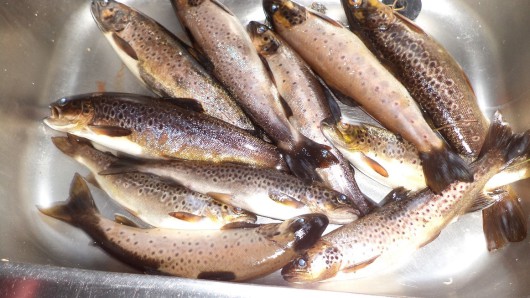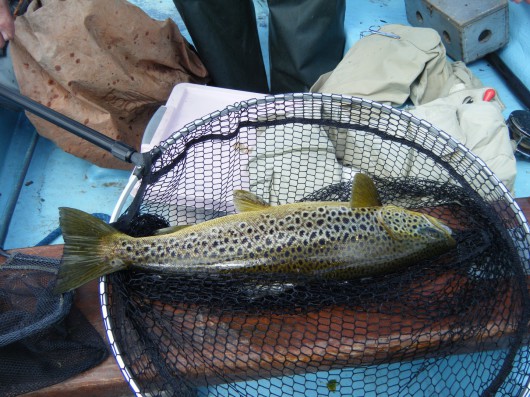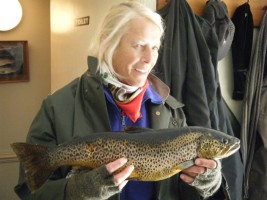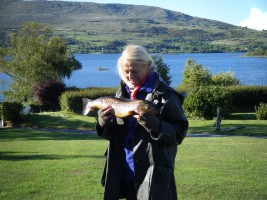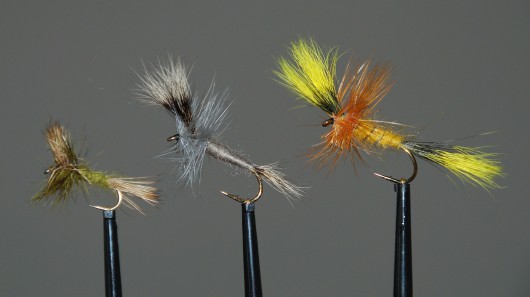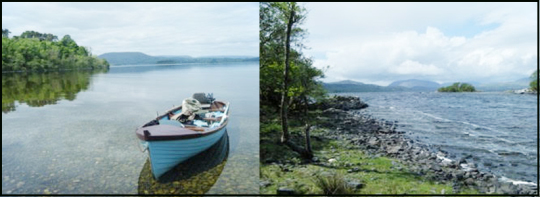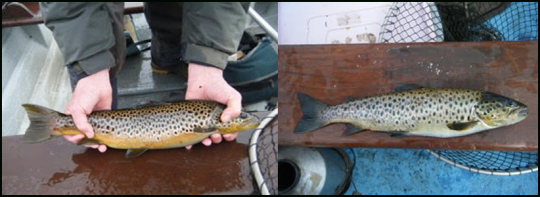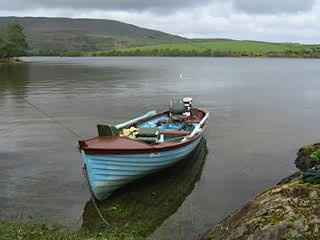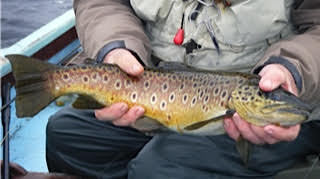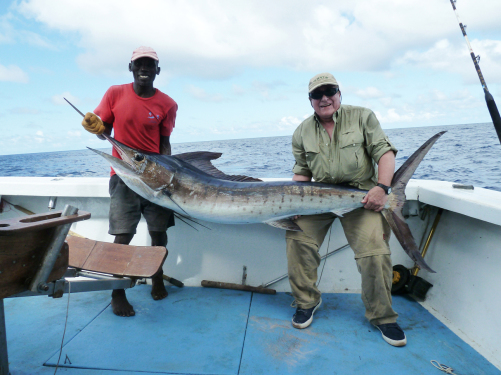Members Articles
Grayling Fishing on the River Ewenny
30th November 2023
My first outing in the new Grayling season 2023/24 was on the River Ewenny in South Wales on a 3° cold, crisp Thursday morning. Seven members of Area 4 Grayling Society from Herefordshire, Gloucestershire, Somerset, and Wales met up to challenge this water. I have fished it two or three times a year and I am always impressed of the good condition in which PADAC keep this river.
On my last few visits, I have struggled with the access on some of the steep banks and barbed wire fences, but since my last visit the vegetation has been cut back, barbed wire removed, awkward access replaced with two level styles with a steady pole, and steps cut into the bank covered in stone with side supports - a fantastic improvement for those of us who are ageing.
For those who have never fished it, it’s a challenging stretch of water and ranges from narrow 6ft sections to 35ft wide. Along it you have cattle bridges, fords, concrete cattle crossings, a few weirs, rocks, and a salmon run built in. The bed is a mixture of sand, gravel, bedrock, deep and narrow channels with some deep pools, with a canopy of bushes and trees for you to contend with, so a short rod, small flies and side flicks are the order of the day.
For my previous three visits I have stuck to the Moors beat as I found it more accessible, but now with all their work on the banks and being more accessible I can fish it nearly anywhere.
My own thoughts were that the river was running around 8 inches higher than normal, judging by the depth against my boots while on the cattle crossing, but the water was nearly gin clear.
I fished my 5’6” #4 rod with a spider on the dropper and a silver bead white bug on the point. I landed two - both on the point - and two freed themselves. Between us we caught 23 grayling, on methods ranging from wet and dry fly, Czech nymph style, floats, and Tenkara.
On the Moors beat the huge stone blocks first installed by the Welsh NRA, under a flood Alleviation scheme are now even more pronounced with the general clearing of the banks, as you can see small fishing swimming between them.
The weather stayed clear but was very cold with an Icey breeze.
Thanks to Geoff Bevan for organising another fabulous day – a good day was had by all members - and to PADAC for looking after the river and its banks so we fly fishers can access it,
The location 10 minutes’ drive from J35, on the M4.
Andrew Ayres,
WFD, G&CFD, Ludlow FD & Grayling Society member.
Fishing in Wales on Llyn Egnant
28, September 2023
For my last fishing week of the 2023 Trout season and because of my last two fishing trips, in the Scottish Highlands and the North Yorkshire moors, have been somewhat stressful, I have chosen a much more sedate trip to Llyn-Egnant, which is one of the Teifi Pools. The Teifi pools lie a long way to the southeast of Aberystwyth. They are a group of six pools in an empty, little visited rocky mountain region in East Ceredigion reached by a single-track road near the village of Pontrhydfendigaid. This wild barren land is referred to as the “Desert of Wales” (I have no idea why). Then on route, you pass by old ruins at Ffair-Rhos, associated with the nearby ruined abbey of Strata Florida, founded in 1164.
The River Teifi is 76 miles long and originates from one of these pools, Llyn Teifi. It then proceeds down the mountain across fields, through wetlands, towns, farmland, and through narrow gorges until it reaches the sea at Aberteifi. (Cardigan).
This venue came about after picking it out from the book, “WILD LAKES of WALES” by Ceri Thomas & Alan Parfitt, lake number 25 of 50. This a great read if you like fishing in wild places and don’t mind a hike as well.
Llyn Egnant varies in depth, its maximum in places is 60ft, average around 10 to 20ft. with a total area of about 50 acres, most of it accessible. Llyn Egnant has a single-track road ¾ way round one side with parking spaces around it, then it’s only a few minutes’ walk to the water. If you fancy a walk then the far bank also gives great sport and a back cast free of obstacles. It also reputed to hold some strange strains of trout in its depth introduced by the monks of centuries ago.
Because of the open ground free of any bushes or trees, the Insect life is very sparse. Most fly life is blown in from the surrounding grass lands or heather bound hills.
I was using a 10ft 6ins rod, 9ft furled leader and 5lb tippet of 10ft and started with a bushy fly on the dropper or a Kate Mc, with a Red Zulu on the point. I was going to fish size 10 but have been recommended it’s too big, so it’s down to size 12.
Surface water temperature was 12.9° and wind was from the southwest. As this is a Wild Brown Trout water, and we know they are very territorial fish, the best way, or my way, to fish Egnant is to travel light and keep moving - 6 casts in an arc and move on. At the formation of the edge of the pool, there is quite a submerged ledge on the road side and then it drops of into deep water, so wading is dangerous. I can’t comment on the far bank as I did not go that far.
The water was clear and you could see the odd fish moving around on the ledge, 35/45ft cast out from the bank and as you draw in, you should catch fish. It was unfortunate for me that the dam contractors were rebuilding the top wall of it, hence heavy machinery all around - tankers and generator sets, tracked vehicles everywhere, and too much noise, which I expect sent the fish to the East bank away from the road.
As a site for future fishing it has to well towards the top of the list, plenty of B&B around as it’s around 140 miles from Cheltenham but well worth a try.
Andrew Ayres,
Grayling Society, WFD, C&GFD, Ludlow fly dressers and FDG member.
A Morning Fishing the USK at Llanvihangel Village
30th September 2023
Unexpectedly, I received an invitation to fish the Usk as a guest, which I have never fished before. Why? I suppose the opportunity has never arisen.
The Crickhowell club has a selection of beats, and I was fishing the Bridge Meadow & Pant-Y-Goitre Beats, a selection of eight areas located five miles downstream of Abergavenny with easy parking and access from the road.
Through the gates each side of the road, you then have a short walk to the river across a sloping meadow to the edge, and fairly easy access to the banks. In this short length of water you have pools, rapids, bridge supports, still water pools, trees overhanging, deep gullies, flats over shale, raised Islands and channels - something for any fly fishing person.
I was trying something different: a Shakespeare 10ft, #4, on loan from a good friend coupled with a 55-year-old American reel built by South Bend, floating line with 9ft of braided leader and 6ft of 5lb Maxima-chamelon tippet, and a selection of flies recommended for this beat by a local.
The water was coloured and fast moving; you could wade in the margins but further out was dangerous. I tried a selection of flies, but none of them preformed. A 3lb fish jumped clear of the water on the far side - spectacular sight - but I have to say a wonderful piece of water to fish next season with a dry fly, if I get an invitation.
Andrew Ayres
Grayling Society, WFD, C&GFDC, Ludlow Fly Dressers, And FDG member
Fishing on the Upper Teesdale and Harwood Beck, 25th August 2023
This complementary day ticket was given to me as a result of my last visit on the Lower Tees and having to compete with atrocious weather, which in simple terms was a wash out. However, it did in fact give me the first-time opportunity to fish the high bolder scattered moorland streams of Harwood Beck and the Teesdale river between Cronkley Bridge down to the last pool before the quarry towards Lune Foot - all on the west bank as I was fishing on the Strathmoor Estate waters.
The Upper Teesdale, to give it its correct name, rises on the slopes of Cross Fell, a remote moorland area between Durham and Yorkshire - a land of basalt and limestone rock - and falls into the River Tees drainage basin along with the River Skerne and Leven.
I had never realised how remote and rugged this area is. I purchased my day ticket from the butchers shop in Middleton in Teesdale for £6.00, and this gave me nine miles of water and a map. I had to drive another 28 miles of narrow Yorkshire lanes to reach the starting point. As I turned off the lane on to a type of bridle path, or track, there was a sign which read, “Fisherman go slow, livestock around you, watch your sump and exhaust and keep to the right as you cross the cattle grids”. A further two miles of track and I park up. The track consisted of steep ups and downs, hairpin bends, a ford with camber completely the wrong way, slippery slate rock, track surface awash with running water. It would have been ok if you’re in a John Deer tractor or a 4x4.Jeep.
I was again with Jonathan, a local of these waters and knows them like the back of his hand. We set up two #3w 10ft rods with double taper line, 5ft furled leader, then 5ft of 5lb mono tippet, one dry fly and the other a duel set with dry, and wet flies. The flies were a black magic nymph on the point and a type of F fly on the dropper made of a mixture of CDC with a peacock body, all on size 14 - and we stayed with them all day.
I am used to wading on Welsh bed rock for hours at a time with a stick, but these shallow waters of slime covered boulders are something else. The plan was to walk up the edge of the river for about two and a half miles, then on the return we would fish the pools and then pocket fish, the small pools.
It took me a good two hours to pick my way along the bank, sometimes in the water where fences mark boundaries. I took two ducklings along the way, got tangled in a gorse bush, and found myself lying on the bank absolutely exhausted twice. My thoughts ‘I am getting to old for this, and could I get mountain rescue to get me back.’ Up I get and off I go again and 20 minutes later I am at the point where we start to fish.
The sport was fantastic - all thoughts of the walk gone the sun is out and I am drying out - we both caught fish at one point. Jonathan hooked a 3lb approx. trout; it jumped out landed back and snapped the 5lb tippet. We caught a total of 26 fish. My best fish for the day was 1.5lb and three between ¾ and 1lb. I lost a few, some self-despatched themselves, all wild and fighting hard to get them in the net. And then it’s the return journey.
I have never pocket fished before, well now I know you fish the same set up although shorten the distance between the flies to a max of 14 inches. Basically, you fish a lagoon type area between the boulders off the main flow of water. If I was fishing the Wye on the pylon beat I would just wade out over this area, never realising it holds fish.
I had to rest again, but eventually I got back to the car. What a day! I got back to base nine hours after I started and short rally stage to get back to the lane - on the second attempt I got up the slippery stones.
On reflection a great day, fabulous sport, fantastic river. Just shows you’re never too old to learn other fishing ways. Only problem the mind is all go, but the rest of the body is slowing down.
Andrew Ayres
Total mileage 565
Grayling Society, WFD, C&GFD, Ludlow fly dressers and FDG member.
Scottish Fishing Trip to East Sutherland and Durness Lochs May 2023
This is my first trip across the border since Covid and our health scares four years ago - so many changes.
So, a new base - the 47000-acre Badanloch Estate in East Sutherland. At first glance nothing seems to live or inhabit this vast emptiness of land, except 2600 acres of trout and salmon river and lochs, red deer roaming wild, flora and fauna growing wild, and as you stand and listen to gentle water movement from the Helmsdale River or the eerie silence around you, a golden eagle watching from above. Also, a new hotel, the Garvault Hotel, about 39 miles up a single-track road with passing places.
When you turn off the A9 at the village of Helmsdale, it’s situated northwest of Kinbrace on the edge of the Badanloch forest. The Hotel transport is a Land Rover with a snow plough attachment and a Snowcat. That said it all - all surrounded by open moor land as far as you can see.
To you salmon fisherman, this estate is the source of the famous Helmsdale River which flows south through the estate, and I expect you all will be aware of it. It also runs alongside the single-track road from its source, Loch Badanloch, to the North Sea. In fact, the day I fished the first loch one of the estate guests had a 32lb fresh Salmon out of the river all silver very clean.
Garvauli Hotel
Lower Helmsdale River
Upper Helmsdale River
Badanloch Estate has been run as a family trust for decades. It consists of six main Lochs, three of them are inter-linked and were formed when the Badanloch Dam was built by the estate owners. It was the first of its kind in Scotland in the early 1900s, and its purpose was to keep the water level up for the salmon in the Helmsdale River. The three lochs are a total of 2300 acres and are 500ft above sea level. The remaining other three are hill lochs spaced around the estate in the hills and moorland.
My plan is to fish the hill lochs of Loch Druim a Chlabhain, and Loch Coire nam Mang. OS maps 9 and 10 and a compass are required. First this involves a 2.9mile Argocat journey northeast across the moor to reach them. Loch Druim is 50ft deep and Loch Coire not so deep at 15ft deep. I leave the order of the lochs fished to the gillie as he has to arrange transport and boats for each Loch. At this point I have covered so far 765 miles at 65.6 mpg (petrol).
Day 1 I am collected by the gillie in a Nisan 4x4 truck, and we are off on a seven mile forestry track to the Alltan-Fhearna Loch to the boat pier. Constant heavy rain and wild winds; fished for six hours and caught seven around 1lb and lost a few, all on size 10 and 12, colourful flies. Good heavy boat with a motor and a bilge pump fitted.
The gillie known as Paul was very professional in his ways. He could read the weather, rain clouds and when rain was arriving, by just looking at the sky.
I would say difficult fishing and I had forgotten my sea sickness pills! I fished my standard 10ft rod three fly set up, but found it difficult getting the leader back cast against the wind. I could get the line back but the leader was already on its return. Paul suggested he changed the leader for one they use in the wind, and its colour matched the peat stained water. What a change, perfect three fly back in harmony. The only problem the actual force in both arms with the cast and fast retrieve was going to kill me, and this only the first hour of 3 days of this.
Boat on Loch An Fhearna
At one point Paul said we won’t get back before the winds hit us and that he would drop me on the shore and walk the boat round to the next bay for shelter. Keeping the boat away from the loch edge and the rocks, chest-deep he waded the boat round. He told me to walk round the shoreline and meet up when the winds had gone over.
On my walk I came across an old boat shed and when I asked Brian about it, he said he hadn’t been in it since 1965. I had sandpipers, divers, terns and oyster catchers for company.
I caught 6 Trout a 1.5 lb beauty with coloured spots, but lost some. I changed to size 8 later in the day and still caught a few. By 3.00 pm my arms were dropping off.
Day 2, it’s the first of the hill lochs, Loch Coire-nam-Mang. We meet at the hotel with the argocat, load all the fishing kit including the outboard motor, and off we go up the mountain along sheep tracks for 3 miles - Paul in the back and me up front with the head keeper of the estate, Brian. He is a mine of information and has been there since 1956. He dumps us out at the boat house and says he will be back at 3.00 pm to collect us.
Weather is the same but now we have sleet storms as well. Although the boat is slightly smaller it’s still heavy duty. The wind and sleet were not forgiving. I caught 6, one being 1.5lb with nice spots. I put it down to another hard day’s fishing.
Lying on the heather waiting for a lift, with all our kit left in the boat shed as tomorrow we go even further on for another ¾ of a mile to the next Loch. On the way back Brian was telling me that every year they come out with their spade to clear the burn by the side of the boat shed as the salmon come up it to spawn - see photo. The scenery is breath-taking although a little intimidating when you’re stuck in a rocking boat alongside Ben-Grian, a slab of mountain rock 580m high.
Loch Coire
Argocat
Track
Day 3, same trip along the various gullies and tracks to the boat shed, we are loaded up and off again, this time in the edge of the loch to get do Loch Druim-a’-Chiliabhain.
Loch Druim Salmon Burn
Loch Druim
Weather is slightly better, rain has stopped but not the wind, caught four plus another 1.5lb, and as lunch time had arrived, we went to the boat shed which gives us a dry space to shelter and have lunch.
I called it a day and for the last few hours we chatted about fishing in this area. By now my arms have nearly dropped off, my fingers are numb with the cold, and my back is about to part-company with my body. The next 3miles in the Cat with no suspension across the open moor to get to base, I have to ask my self is this all really worth it. YES! No question about it.
For anybody planning to fish highland hill Lochs, they can be in some very unforgiving areas, and the weather can be very harsh and spasmodic. Be sure to make sure you have company and the correct clothing, and you have checked the area out.
Endless Views
In the case of these last two lochs, approximately four to five miles away by track, I sat in a boat on a windswept loch whilst Elaine was in sunshine three miles away in a straight line.
Through the winter they feed all the wild deer with cake, spaced out on the single-track road on the grass verge, from a tractor and trailer so as to keep them in first class condition for the shooting season as the deer can’t get any food with all the snow on the ground. As soon as the weather improves, they move off to high ground.
The hotel we have been staying in on the moor is classed as the most remote one in the UK. It is run by an eccentric but very pleasant couple. Just to give you a few facts, no keys to lock the bedroom door, although when asked for one, it was given, no tea & coffee facilities, no hair dryer, no telephone, no mains power. Electricity is provided by three portable generator sets - Lister (WW2) type, a modern Kabuta, and some solar panels. There is, no menu and all guests eat at a long table together. In his Garage he has a 1968 Triumph Vitesse convertible and a 1967 Bristol Grand Touring, both in need of some TLC, and a Mercedes road-car. They don’t take credit cards - he just said no problem, pay us when you get home.
On the last night about 8.00pm all the power went out, and when I got the bill, he had made a £20 reduction for any inconvenience. I think we were lucky with the other guest as we got on well, a critical-care nurse from Durham and a Lotus engineer from the Colin Chapman era, who turned out was rallying in my days, same year, and same events. Small world and while sitting talking to Paul on my last day with him, he said “last night I was telling my friend Duncan I had an old club rally driver with me in a boat, and he said ask if he knows my Yorkshire fishing mate Bob Bean, who used to do rallies”, and yes, I did compete against him in 1970s. When I asked where he was from, he replied
“A small hamlet in Wales, you will never have heard of it”.
I said, “try me”.
He said “Abergwesyn”, and I replied
“Yes, I know exactly where it is. We in the 60s/70s rallied all round there and furthermore my caravan is at Llangammarch Wells about five miles away in a straight line. Now that what I call a small world.
On our route from Kinbrace to Tongue on the North coast we met up for lunch with my old Gillie, Walter, from my previous year’s fishing Altnaharra Estate. He has now retired and invites me on another visit to fish Loch Shin with him. He now gets free fishing as he lives in the village of Lairg. In my past Scottish fishing reports, I always raved about the Crask Inn on the Lairg road for its beautiful glens, streams, wild windswept moors. Now as you pass the Crask Inn you are faced with the Creag-Riabhach Wind Farm, 17+ windmill turbines. The once narrow track has been widened, concrete culverts built to change the direction of the river which is now dry, bridges built and buildings everywhere and a further four miles on there is another in construction, all the pylons made from wood anchored down by thick wire rope, on huge concrete bases, just going out as far as you can see. Destruction of a beautiful landscape and they call this progress.
We are now in Tongue, a rest day as no fishing allowed on a Sunday.
Day 4, I am fishing the Durness Lochs. I am booked on Lanlish Loch bank fishing, 40 miles each way, most of it single track road with passing places, full of motor bikes and motor homes. The fishing was bleak, never had a take, never saw any sign of a fish, and the return trip took over two hours, so I shan’t be going there again
Durness Loch
Lanlish Loch
Day 5, fishing Loch Loyal - another disappointing day, bank fishing both the north-west bay and at its original source as it flows under the bridge. The river is so weedy you are almost unable to fish it, and the northern stream is dry, barely a trickle.
Loch Loyal West Bank
Loch Loyal Bridge
Loch Loyal Feeder Burn
It is difficult to imagine that the lochs are about between 1.5 to 2m down from their average water level for this time of the year, and rivers like the Garry are seriously low. Another disappointing point of this trip is the old fishing hunting lodges/hotels with their gentle, relaxed atmosphere are being sold to European owners and then changed to B&B or fast-food outlets, and the new owner doesn’t even take on or renew the fishing lease. Some 60 plus years old all the history is destroyed and replaced with modern decor.
I think the weather was against me and I was four weeks too early in the season. So a mixed trip - the fishing could have been better - but not all bad, good company, but next time I need to study the hotels in the east better, so as to replace my old haunts.
One of the best bits of this trip is catching a trout on a size 8, never used size 8 before, just dribbling it on the top dropper over the waves and he came up from the depths and took it between the waves crest.
And the Argocat trips, fantastic piece of kit, fitted with a winch and all weather cab, roll cage - and they swim.
Elaine reckons I should get out more and get a life!!
Total mileage 1460
1st section 65.6 MPG
2nd section twisty mountain section up and down road 56 mpg
3rd section 75/85 mph 65.1 MPG
Best accommodations Moffat, B&B excellent 5*
Premier Inn Inverness never changes - always first class in food, accommodation and service.
Andrew Ayres
WFD, LFD, C&GFDC and Grayling Society Member.
Fishing LLyn-Efymwy, (Lake-Vyrnwy)
06 April 2023
This magnificent lake in the Powys/Gwynedd border district of North to Mid-Wales has been a magnet to the fly-fishing world for 90 years, for both ladies and gentlemen. It kept challenging them and drawing them back to fish, time and time again.
Work started building this fine masonry dam in 1881. Looking at the dam today, you see a mixture of Victorian architecture and Gothic style in its ornate topping to the spill arches and fine towers. It was completed in 1889, and its purpose was to supply fresh water to Liverpool through a range of 90 miles of pipes and stone aqueducts, all fed by gravity as the dam is 800ft above sea level. Then the two valleys Llanwddyn and Vyrnwy were flooded to give an area of 1121 acres of water. The Hydroelectric turbines were installed many years later.
A fish stocking program in the beginning was with 400,000 Loch-Leven brown trout from Scotland. Over the years rainbow trout, brook trout from the USA, have all been tried. Now restocking is about only 400 rainbow trout a year.
Around the lake the trees come down to the water’s edge, and the sides are steep Cambrian rock and moving shale edges. There is no bank fishing - boat only. The depth behind the dam wall is 85ft and for the few decades after it was being built there was plenty of food from the rich valley grass, but as time went on it got less and less as the original surface soil was washed away and dark acid peat water from the mountains destroyed the vegetation.
As the lake is long, narrow, and curved, it has many bays and indentations served by torrents of streams and rivers - all a good feeding area for fish where they flow into the lake. At the shallower north end in Rhiwargor bay and Island area (now also a 16000-acre RSPB reserve), in the summer months when the water recedes to allow the grass to grow through, it makes a fertile area to fish when the water returns.
The lake has many waterfalls and brooks emptying into it, an ideal area for feeding and these are always a place to see fish searching for food. Today most of the food is terrestrial, blown in off the trees, or bugs below the surface.
The markings on the fish can be quite different. Those who have stayed at the dam end are darker and less spotted to those at the northern shallow fertile end of the Lake. As seen in my photo of a ¾lb+ beautiful fish with bright clear red markings and a wonderful gold colour taken ¾ mile up from the dam on east side, before the tower structure.
In the early years 1905 onwards, the yearly count of fish caught was 4500 approximately. Today it’s maybe around 3000 - guide figure only. No WBT are stocked, although there are plenty in the lake.
For my fishing day here, I was fortunate to be with John Davies, a veteran of Vyrnwy fishing, so hopefully I acquired some boat handling experience and tuition as well - it was my first time in an electric powered boat. As I have said many times before, there is no substitute for local knowledge.
We set off to the boat stage park with two batteries, electric motor, oars, and our kit. No assistance given you collect your bits - you sign for your boat and it’s down to you.
The water was freezing, so sinking intermediate line, two droppers and point fly. I fished my colourful deer hair experiment flies consisting of JC, red legs, hen dyed feathers, SQ and dyed tippet, all on size 10 and caught fish on them. for a total of five hours. All these patterns were tied for fishing the Scottish Lochs next month. 12 were caught with a very fast retrieve; all fish all returned.
As you go out of the boat pier under the bridge into the lake, we fished down the east side - may be 200 yds, passed the tunnel which was built when the dam was constructed. They built Two tunnels, one on the east and one on the west side to drain and divert the water of the Conway and Marchant moors and valleys into the lake. We then fished back in front of the tunnel and bridge then up towards the tower. There are many nooks and inlets to cast into, but always staying 100ft or less from the bank vegetation. We then went across the lake to the other side, now fishing the west edge again. So many places to try and find fish.
The weather was bleak, some nice sunshine, but when it changes the wind blows down the valley round the curve and you then get the full blast of ice-cold air and then the rain and wind, so you scurry to the bank for shelter. These electric motorboats don’t have the power as the old petrol ones had. Always have a spare battery and don’t attempt to cross east to west if the wind gets up; just wait till it blows over. Overall, a very enjoyable day, soon hopefully to be repeated later in the season.
We found a good three-star hotel in a local village that does BB as well as evening meals. As stated, 12 WBT caught in the net and probably a further 10 were lost to not being quick enough to retrieve and hesitation between pulls. The WBT are very fast and the slightest hesitation in between the pulls and they are off and gone.
As you see from the lake sketch, I only fished the area marked in red below the tower structure and the tunnels, but plenty of other areas to fish. If you want to fish the north end you collect your boat at the White-Gates boat yard, ¾ of the way up the lake on the east side; but be warned, you will need a 4x4 to get down the track to the boats - far too far to carry batteries and all the other kit required.
Next time I visit I shall try and fish the Cedig Bay area both east and west sides. Even this is a long way from the rich feeding area of Rhiwargor Bay. Again, I will collect my boat from the Boathouse Pool boat site at the dam end.
Andrew Ayres
WFD, LFD, C&GFDC and Grayling Society member
Grayling Fishing at Builth Wells Area 4-day
23 February 2023
On a mild Thursday morning, 23 February, I went to the last Grayling fishing day of the 2022/2023 season for the Area 4 Grayling Society. I started at 5.00 as I needed to go to Cefn-Gorwydd before the fishing started. A fresh clear no frost morning, although it rained while going through the Golden Valley area, (Ross to Hay).
This water is controlled by the Groe Park and Irfon Angling Club. They have several miles of the Wye and Irfon banks to fish. There are 10 beats plus a new one added last year, named LLyn-Alarch beat, further along the Irfon River, for the fly and trotters/worm, to suit all members.
We all met at Gregg’s car park to sign the risk declaration form, pick our various beats - although we could alternate between beats during the day as there is so much choice where to fish. 10 members attended and the fish count for the day was 15 Grayling, five Trout, and two Chub.
The day ticket is £8.00, obtainable from the newsagent in the main street, which opens at 5.30am. When you buy your ticket, you are given a map showing all beats and access with parking. Unbelievable value for fishing for a river of this quality. Some banks to climb down, but all with wader protection on the wire, easy to manage stiles and many areas where the water’s edge is readily accessible. Wading is good but a stick is always recommended. Normally when I fish this water it favours the worm fisherman, but not today - too many of them were blank at lunch time. The water was low and clear with quite a fast current. The weather was brilliant for the time of the year, 8 to 10°, and sunny with a steady wind, which did cause some lost flies and tangles.
I used a 10ft rod, 4lb line with a 12ft leader and two droppers although I changed later to one. As for flies, I used bugs with gold and black beaded nymphs on 14/12 hooks.
It was a very tricky water to fish on the day, and although I used a jig hook on the point, I still lost it on submerged obstacles along with three more flies. I have always fished the same area - beat 1 pylon beat and beat 2 the fly only section - for easy access and not too difficult wading. It depends on the height of the river as to how far you can get your fly across to the far side as all along this far bank is a very deep channel, ideal for larger fish if you reach it.
Altogether a great day was had by all. Weather was superb, good company and nice to meet old friends who enjoy the sport, it’s not always about the quantity of fish you catch.
My thanks to Geoff Bevan for organising another great Area 4 day.
Andrew Ayres,
Worcester fly Dressers, Grayling Society, Cheltenham & Gloucester fly Dressers, Ludlow fly Dressers, Member.
Fishing on the River Tees 17 November 2022
The river Tees starts its journey east from the beautiful scenery and wonderful barren moorland of the Northern Pennines at Cross Fell, where it then winds its way for 85 miles east to meet the North Sea at Middlesbrough.
I had arranged to fish Pierce Bridge and High Coniscliffe, beats on the Tees, in the Darlington catchment area. Unfortunately, the weather was very poor, and as always, out of our control. The forecast was as we thought, going to be high water but ok to fish.
When the gauge was checked at 8.00am in the morning it was 6 inches up. By the time we came out of the river at 2.30pm it was the colour of chocolate and had risen a further 6 inches, and it had been raining a monsoon since 9.00am. Now we had quite a wave with channels of foam racing down in the fast current, and it was unsafe and too dangerous to continue.
This river, although was high, it was a good colour when we started and was certainly fishable - very much like the Dee at Bangor with a wide very safe shale riverbed - ideal for wading. In fact, I did not use a wading stick at all.
My partner for the day was Dr J Barnes a well-known fisherman in the north who is a Czech nymph expert. This was my first time to fish the Czech nymph style, which is popular all over Europe and becoming very popular here. When he looked at my rods, flies, reels, and line he shook his head and said none of these are any good for proper Czech Nymphing, so he kited me up with his own gear, 10ft6in, 2w rod built by Marryat Rods, no fly line just Stroft tippet 2.30kg on to a backing line, a 3m bead on the point, 2 further nymphs on 2 droppers 18inch apart. The whole set up was as light as a feather.
He explained to me where the grayling shoals normally lie in these conditions - in the margins - and where and how to fish this set up. Indicators are very important on how you feel the fish takes with the Jig hook on the point, as it just bounces along the riverbed, which makes the takes whether from fish or on pebbles, which it bounces off, difficult to determine. Whether it’s a fish or a stone, or in my case a drowned leaf, gives the same effect. Basically, you fish in a 60-degree arc, never using more line than you started with. In my case it was 10ft. Be sure to clear the water with all the flies before you flick back up stream and instantly get your indicator in view and watch it like a hawk. You defiantly need Polaroid glasses for this style of fishing and concentration.
I found it a fascinating style of fishing having never done it or anything like it before and now I need to try it on our home waters. I caught one fish, a Sinkey Baby Grayling, which is the name given to it by the northern fisherman. On the 10th December I have a Grayling Day on the Ewenny so this is an ideal water to try this method out on with 5ft 6in rod.
I was given an FOC return day as the weather was so bad. On my return we are going to fish high up on the Pennine moors for trout when the season starts in 2023.
As I took Elaine, my wife, with me we stayed at Headlam Hall, a beautiful, renovated country club. No complaints, top class in every aspect.
The round trip involving two motorway diversions, was 528miles.
Andrew Ayres,
WFD, Cheltenham Fly Dressers, Grayling Society Member.
Fishing the River Ewenny on an Area 4 Grayling Day
29 October 2022
My first Grayling fishing day out of the new 2022/2023 season. The last time I fished this water I said it was too hard climbing up and down the banks and I would leave to the younger generation, but while in discussions with another fisherman at a Grayling Dinner, who knew this water well, he suggested I try once more and fish the Moors area.
The river Ewenny starts off in the moor, north of Bridgend, and winds its way down through villages, woods, across moorland, under a motorway where it feeds into the Ogmore estuary. There is now a good head of Grayling in both the Ogmore and the Ewenny. You can also catch the odd Salmon in them.
The Pencoed & District Angling Club (PDAC) water is a challenging stretch of water. It ranges from narrow 6ft sections to 30ft wide and along it you have bridges, fords, concrete cattle crossings, a weir, rocks, and a salmon run built in, stiles, and steps cut in the bank with anchored ropes. The bed is a mixture of sand, gravel, rock, deep narrow channels, and deep pools with a canopy of bushes and trees, so a short rod, small flies and side flicks or roll casts are the order of the day.
On this day as we were warned the water would be high and fast, well coloured from off the hills, so be very careful.
I fished the Moors beat (2 parking spaces here) going towards the former Ford factory, about a mile from the PDAC car park. You walk across a field and on to the cattle crossing. Here you can wade, up or down under normal river conditions.
While getting kitted up some dog walkers suggested I went through the next gate across the field and over the foot bridge. They said the banks have been trimmed back and there is river access (I always listen to the locals). Well, what a difference - gentle slopping banks, repaired styles with a support pole. You still must wind your way through the trees and watch you don’t trip over tree roots, or meet the odd cow, and although the water is flowing fast there are plenty of pools and quieter water to cast a fly in.
I fished my 5ft 6ins 4w rod, 6ft leader and caught one grayling, on a pink tungsten bead pupa on a gig hook 16. I tried one of Karl’s nymphs first but no takers on that - it needed some sparkle and colour.
PDAC must be congratulated on their improvement to their water and access. I will now certainly be back to try the other two ends of this beat.
I met Tony Protheroe while packing up, just as the rain came in. He was passing by, so he stopped. We swopped some stories - we have mutual friends from my rallying days - tried to put the world to right and then went on our ways.
For me a great day; it’s not always about the fish. I left the main PDAC car park early to go and get a parking spot on the other beat. What I didn’t know was that only the Area 4, Secretary Geoff Bevan turned up, which was a pity, as it was a good dry day.
Andrew Ayres
WFD, Cheltenham fly Dressers, Grayling Society member.
Grayling Fishing on the Ty-Mawr Beat
4 October 2021
Ty- Mawr is set in stunning beautiful country, deep in a valley surrounded by wild mountains covered with lush shades of green trees. As you turn off the main road stop at the top of the farm lane, take your time to study the view of the river below you. In the distance you can see the end of the beat right hand side (Hendre Farm bridge end), as the river twists through a series of tight bends and covered vegetation areas. To the left hand side you can see for ¾ of its twisted route through open fields and the boundary of a small spinney. (Binoculars’ would be handy).
This beat is some 2miles from the start of the Wye at Plynlimon, high up in the Cambrian Mountains, where it starts its 134 miles to the Seven Estuary at Chepstow. As you drive down the mile and half lane to the cattle grid to park up, the river is 100yds in front of you.
The last time I fished this beat was October 2020, when it poured with rain the whole time - torrential rain - after several hours I returned to the car and went home. Today the sky is blue; it’s warm, although showers are due in from the west later today.
Today I was joined by Tony Mitchell, a member of WFD and C&G Fly Dressers: his first time fishing the Northern Wye.
This beat is approx. one and half miles - both banks are available to fish. Where we park by the cattle grid is near the middle of the beat, so Tony went down and I went up the river, then to meet back at the cars for lunch in 3hours time and then swop beats. Neither of us made it to the beat ends in the time given.
Although it had rained heavily for days before we arrived, the river was not flooded but the channels were full, and the current was very strong and extremely powerful. The edge channels were 6/7ft deep, the pools even deeper, so to fish this beat without a wading stick is suicidal. In these conditions the water is gin clear, but be very careful of the dark black water. Do not try and enter this as it will be very deep.
You will have to cross this river many times - it’s the character of how the current creates the channels in the winter floods and moves all the stones round. Now whether you go up or down the stream always cross were you can see the bottom, even if it’s a longer route. Both Tony and I had a few moments in the current where we were saved by our sticks, otherwise we would have had a soaking.
I fished this beat last in October 2020 and blanked then and unfortunately, we both did the same today. We were fishing 7/8ft, #3, rods, used gold and red beaded nymphs, standard nymphs, spiders, bushy sedge, long/short leaders, 2 and 3 droppers, also no droppers. I only had one take all day and even then I wasn’t even sure it was a fish.
As I said before, the water was very fast, as noticed when a sedge was on the top dropper, going so fast the other flies did not get down to the bed of the river where the Grayling should be feeding. Even bushy heavy weight nymphs were tried. The only stiller quiet water I could find was under fallen trees, with large boulders and small inlets where you had slower water, but even there the under current was too strong to get the flies down.
The only fish I saw caught was by a Heron. I sat on the bank and watched him for 20 minutes as he stood on the edge of the river. He then took off and flew towards me, went and stood on a feeder stream and promptly caught a small fish.
I lost 5 flies, 1 complete leader and flies. Tony lost 3 flies.
Wild life was wild duck, herons, wren, wagtail, meadow pipit, buzzards, and red kites.
On the fishing, I am not an expert but I think the current was just too strong to get the flies down. I expect if we could have got the flies down in the deep pools or gully, we may have had a different result; but a great day, good company, fabulous weather for this part of Wales, and wonderful setting. It’s not all about catching fish, but one would be nice.
Till the next time, maybe a ball bearing on a 4ft leader and troll the fly down the gulley (desperation tactics)!!
Tickets from the Wye & Usk Foundation for £11.00 phone 01874 712074 ref, Ty-Mawr
Andrew Ayres
WFD, C&GFD and Grayling Society member.
Grayling Fishing Area 4 day, 1st of 2022
13th January at 5.00 am the alarm goes off, I look outside, the car is like an Ice cube and the temp is -3, so by the time the car is warmed up and the windows are scraped it’s 5.50. Time to set off for Builth-Wells, the 1st Grayling Day of the year for me.
I had been watching the Llanstephen river level camera for a few days and could see the levels dropping, but on the last view it had risen so I realised it could be a challenging day.
On the route through the Golden Valley and up to Hay on Wye it was showing -4°C and very slippery. As dawn breaks over the mountains, light begins to show the glistening frost on the hedges and bare tree branches - and in the background I have Rachmaninov playing Rhapsody on the Theme of Paganini - what a wonderful way to start the day.
We all meet up at Gregg’s car park In Builth to sign up and pick our beats. It was good to see new members and faces. Duncan the river bailiff was on hand to explain the new water and where the fish might be. The Groe Park and Irfon Angling Club, whose water we are fishing, had added a new stretch to their beats on the Irfon.
As it turned out the members who were trotting, I believe had the best results of the day, getting 6, 7, 8 fish each ranging from a 4lb chub and many 1lb grayling on the new Irfon beat. Around the Wye bridge pillars, grayling and some out of season trout were hooked. I fished the Pylon beat on the fly, but only one small fish for me.
The water was very high and extremely fast flowing, however, in the margins out of the fast current you could fish safely if you had a wadding stick. I fished a 10ft, 7/8w, rod 4lb leader with 4mm beaded nymph, and also tried the duo method with 2 similar flies.
For £8.00 a day ticket, with such a wide choice of waters and beats, this has to be one of the best values for a day fishing around.
For some time now in the winter months I struggle with grip on the banks with my wadding boots on, even with studs in, so this time I used my old Wellington boot waders, with soles like an old Town & Country tyre tread and I added 4 studs in the heel to dig in if required. The outcome was a great success - much more sure-footed - so maybe it’s not so much old age as having the right footwear!
So I believe a great day was had by all, my thanks to Geoff Bevan for organising it in these difficult times.
Andrew Ayres
Worcester fly dressers, Cheltenham fly dresser, Grayling Society member.
16/01/2022
Fishing the River Irfon “Melyn-Cildu” Beat – 18 March 2022
The River Irfon, especially the upper Irfon, is renowned for its quality Grayling fishing, along with its wrap around stunning scenery.
This beat Melyn-Cildu, is well off the beaten track and lies between the Cammarch Hotel higher beat and the Colonel Beat. Access is off the single-track road between Llangammarch Wells and Llanwrtyd Wells, with the Sennybridge Training Artillery range on one side of the valley and the beginning of the Irfon Forest hills on the other side. The peace is only broken by the Artillery shells going off, which you get used to very quickly.
I was joined by Tony Mitchell. I think he is now getting used to off-route locations and appears to be enjoying them. The beat is only a short walk from the car park, across the railway line and through the field to the river - easy access. The water level was normal and was gin clear with a steady current. In certain places, like most of the Irfon, the bedrock slabs were very slippery, in fact suicidal without a wading stick, but the rest was a mixture of sand, gravel and stones. The beat is a mixture of single and double bank fishing; in all about a mile of flats, gutters, fast runs and deep pools and has a fishing limit of only 3 rods a day.
Tony went left and I went right clad with a beat map and arranged to meet back for lunch three hours on. Well, I waded, I bank fished, hid in the bushes, sat on the bank and watched the water. No sign of any movement on the water or in it at all, and even with the sun out nothing coming off the water.
I fished my 7ft rod 4lb line, tried nymphs, gold head, sedges and dry flies. Point and one dropper was my set up on 7ft of tippet.
Back at lunch Tony had the same story, although he was missing some flies, as his side of the beat was far more overgrown with trees and vegetation.
After lunch we swopped sides and tried again, this time two hours then back to the car. For me I only lasted one hour - completely knackered and we each had to drive home. For the last hour I sat on the grass and watched the Red Kite display, which was absolutely fantastic.
Tony walked back crossed the line, just after which the train went by. He was exhausted as well and said the beats are like chalk and cheese; one is open space and the other well overgrown and wild. He had sat and watched the water and agreed no movement - maybe the otters had them!
We concluded great day, great location, easy access; pity about the fish.
I may have to go and fish the Elan Valley reservoirs to get rid of the blank day syndrome before I come back here.
Last month they were catching 3lb Graylings, on this same beat.
This beat is controlled through the Wye and Usk Passport on 01874 712074
Andrew Ayres WFD, C&GFD and Grayling Society
Fishing the Ewenny River on an Area 4 Grayling Day, 25 September 2021
My first Grayling fishing day out since lockdown 18 months ago, so all kitted up readyto go. The last time I fished this PDAC water I did say it was too hard work climbing up and down the banks, and I would leave it to the younger generation, but while talking to a Grayling member at the last symposium I discovered the further down the river you went to the Moors beat, the easier it was to wade - and the banks are not so steep - so I thought I would try it again.
The River Ewenny rises off the moor, north of Bridgend and then winds its way down through villages, woods, under a motorway, across moorland where it feeds into the River Ogmore and on to the estuary, There is now a good head of Grayling there. Fishing in the river Ogmore, the Grayling appear to come down the Ewenny and stay in the Ogmore; obviously a better source of food there.
The PDAC water is a challenging stretch of water, although low levels due to all the dry weather, but ranging from very narrow in places - 6ft to 30ft, and winds its way through fields. Along the way you have bridges, fords, a weir with a salmon run built in, steep banks with very overgrown vegetation and brambles, although there are plenty of wader protected stiles, steps cut in the bank, and some bank ropes to help you pull yourself up the banks. The riverbed is a mixture of sand, stone, gravel, bed rock, and mud. Along with a fast current in places with some very deep pools and narrow deep channels, a canopy of trees that make sure you use a short rod- only roll cast or side flick casts can be used. Salmon are also caught on this stretch of the river.
This time I fished the Moors beat about 1mile from the car park, by road and a different car park, then a short walk across the field to the concrete cattle ford. At this point you can go left or right, wading up or down the river, plenty of pools, rocks stony channels to catch waiting fish, or as in my case in early afternoon, stand against the bank as the sun rays shine from behind you on the opposite bank and half the river surface, you see the grayling swim by or come out from under the far bank stones. As the water is gin clear, stalking the fish is the term used. Here I used my up winged olive and watched it taken by one inquisitive Grayling as it floated down stream.
I fished with a 5ft 6ins 3 weight rod, 2lb x 4ft leader on a dry line with size 16 up winged olive, a black bead nymph and a daddy most of the day. I caught 3 x 7/8ins grayling, beautiful young looking fish. A PDAC rule is all removed barbed flies, but now you can fish a dropper, (one wet & one dry).
A great day although somewhat tiring, me being out of practice, and always watching the stones and being careful not to lose flies in the overhanging vegetation.
Another Area 4 day organised by Geoff Bevan, and as always PDAC were on hand when we arrived, to supply, coffee, tea, and biscuits and collect the fees. An extra nice touch by PDAC to finish the day was that we were given a complimentary free day fishing as a group or by ourselves in the future.
The PDAC look after this water, banks, stiles, and water approaches very well and it’s a credit to them.
PDAC = Pencoed & District Angling Club.
87 miles from Cheltenham to J.35 on the M4 and a 10min drive to the PDAC car park.
Andrew Ayres
WFD, Cheltenham Fly Dressers, Grayling Society member.
A red-letter day and other reflections
They say every dog has his day but for me, when it comes to fishing, those days are rare indeed; I am more fishing Chihuahua than fishing Rottweiler. A few Tuesdays ago, on the Monnow my luck changed for an all too brief period of time.
I was fishing in the company of Steve Cole who, as well as being an excellent fisherman and fly tyer, is a thoughtful and generous fishing companion. I am indebted to Mike, an esteemed member of this branch of the Guild, for introducing me to Steve. The last time I took Steve to fish on my "home" water close to Grosmont, he effortlessly out-fished me. I was expecting no less of a drubbing for our more recent meeting which was to take place further downstream in the delightfully quiet valley that lies just over the hill from Skenfrith. This time, against all sensible expectations, I caught 12 fish to his 7 but the day will live longer in my memory because of the heft of one of those fish. How I came to catch that fish and its smaller companions has, like pretty much every event in life, a journey attached to it.
In the early 1990s, I joined the ranks of a large international law firm. There I met a lawyer who was not only both professionally talented and diligent but who was also clearly obsessive about fly fishing. To save his blushes, I will call him "John" (which is a remarkable coincidence as that also happens to be his real name). When we first met, John was a member of the Salisbury & District club and spent his weekends staying in B & B's and guesthouses in and around Salisbury and Wilton. At that time, I was very definitely not a fisherman and, like most of us who worked with John, found the seriousness of his passion to be more than a little odd. We eventually lost touch when I moved to another firm and then later left London altogether to work in Birmingham. When I re-met John many years later, I had just started to fly fish. By that time, John's career had taken off in the way most of us would have predicted; whilst still a member of SADAC, he had joined an historic and exclusive club on the Wylye and exchanged his rented rooms for a delightful cottage in an equally lovely village located near the River Nadder, west of Wilton.
Many friends have helped me on my fishing journey. In the same way that two (Philip and William) have helped me to become a semi-competent salmon fisher, I will always be indebted to John for the way he nurtured my interest in fly fishing for river trout. He regularly asked me to stay in the cottage and fish the Wylye as his guest. To begin with, this proved as productive (and humiliating) as asking someone who can barely kick a football to turn out for England against Brazil at Wembley stadium. In those early days, when no brown trout would even inspect my unworthy offerings, I was eternally grateful to the odd grayling which would take pity on me. As a result, whist many trout purists sneer at the grayling, they will always have a special place in my affections. On those visits, I learned much from John; the need to wade as stealthily as possible, the need to use long leaders for spooky fish and his thoughts on fly choice (about which, more below). Just watching him going about his work methodically, like a large lethal heron, was an education in itself. I came to love the Wylye and it remains the chalk stream I would choose above all others.
Although I love the Wylye, the Avon, as it flows gently south and crystal clear through Wiltshire, runs it a close second but for very different reasons. I was born in Salisbury and lived there until I went nervously to university aged 18. My father liked nothing more than spending warm spring and summer evenings in the beer gardens of various local pubs and only many years later did I notice a common theme; the proximity of running water. He loved a particular pub in the Woodford valley where, as a boy, I would stand next to him on a bridge over the river as he pointed out the stealthy trout. Those fish etched themselves more deeply in my subconscious that I could have realised as a child. I was fascinated by how those nearly invisible creatures were the masters of their environment, hovering virtually stationary above the pale gravel until, with the merest flick of their tails, they would account for some hapless insect above or below the polished surface of the water.
As I grew taller, I found that I could reach an old fishing rod hung high on a few nails driven into the wall of our garage. I was fascinated by the impossibly long and whippy rod which was a lovely milky pale green colour which I now know to have been fibreglass. Attached to it was a reel and on that reel was a strange line that crumbled and snapped as I played with it; silk lines are made neither to withstand damp filled neglect nor the uncaring hands of a child. Only many years later, after my father had died, did my mother explain to me that he was a keen fly fisherman whist stationed in Europe but felt that river fishing in Wiltshire was too exclusive and expensive on a retired army sergeant's pension. I played happily with his rod and reel as a child but now, as an aging fisherman, I find the thought of him hanging those things up never to be used again unbearably poignant. In the same way that I wish I could now own the black, left-hand drive Mercedes that he bought in 1960, allegedly fresh off the production line, I wish I still had that rod and reel. All were scrapped. What was not lost is the interest in nature, and, in particular rivers, that he kindled within me.
All of which takes us back to my recent day on the Monnow and "that fish". Like so many of us who fish, I spend too much time fretting about which fly to tie on. I lose trust too quickly in the chosen fly and I spend far too long looking at catalogues and websites in the hope that some Holy Grail of the fly world will appear to me in a mystical and revelatory fashion. John takes a far more sensible, simple and effective approach to fly choice. If fishing dries, he turns to comparaduns or Davy's sedges. On the rare occasions that trout won't play and he needs a nymph, it will be a PTN, a Copper John or, in recent years, the alluringly purple Duracell. But when the Mayflies hatch, dance in the trees and die on the river's surface to float away like so many thousand tiny Ladies of Shalott, there is one fly, and one only for John; the French Partridge. John creates his own for the Wylye; a drabber version of the shop sold flies. I have a few of his but they are now impossibly trout eaten specimens, so for the Monnow I tied on one which I had purchased during a "work trip" to London. Ignoring a splashy riser under an over-hanging bush, partly because I suspected it would be small and partly because it would have needed a cast far exceeding anything I could muster, I focused on a confident "sippy" rise a couple of feet below. Unusually, my first cast was pretty much spot on and I tweaked the landed fly a couple of times to give it some life. The French Partridge disappeared almost immediately and after what seemed like an eternity, I netted a very angry, powerfully built wild brown trout of nineteen and a half inches; a big fish for the Monnow and comfortably the largest I have caught on that river. Another debt owed to John.
In the days since, I have occasionally felt in danger of feeling rather smug. When I do, I hear the voice of an old friend whose favourite saying is "even a broken clock is right twice a day". I may be a broken clock but, for now, I'm a happy one.
Jim Sharkey
Fishing Elan Valley Reservoirs 29th June 2022
You will all probably be aware I have been in a lockdown situation since Covid 19 - hence no meetings or gathering for me and will be for a few months more yet.
On my lonely fishing trips this year I have struggled with my balance - I put it down to old age and bones not so flexible as they once were - especially when wading on Irfon bedrock. Once or twice I have had a few heart-stopping moments, with only my wadding stick saving me from a soaking.
So, I decided to bank fish for a while like I do on the Scottish Lochs. Where do I find some lakes like the Lochs with the wild rugged scenery? I chose the Elan Valley Reservoirs. Having had some helpful tips from George Baron, especially on the wind directions. On the day this determines where you start to fish, East or West bank.
From Cheltenham across country, it was 91 miles to pick up my day ticket from Powell’s in Rhayader. From there I chose to go the old mountain road then drop down at Pont ar Elan, cross over the road over the cattle grid on to the East side of Craig Goch Reservoir. Then drive along a narrow lane, (old rally stage) to a small field entry by the bridge and fish the bay inlet - a further 25 miles.
I had given Tony Mitchell the map reference to meet me in the gateway. Now this is where with the best plans in the world it all goes pear-shape, big time. First, at Powell’s I am told the reservoir is undergoing repairs and is being drained; second, while driving thinking what to do I miss the mountain road junction; third, as I start to go round the old road to meet Tony, I find traffic lights and road closure everywhere - I gave Tony the map reference but he would not be able to get there - forth, no phone signal.
I choose to park up at the first dam, Caban-Coch, have breakfast and see if Tony came this way. How I missed the junction I don’t know as I have been over it hundreds of times over the years in my rally days, and how much we rely on our mobile phones. All these reservoirs were so low on water you could not fish them safely - the banks were moving shale or thick sinking mud.
After a couple of hours, I went up to the last Elan reservoir and dam to be built, Claerwen, and fished there. It sits on very high land - the biggest reservoir of them all. In fact, it holds as much water as the other three put together and was opened in 1965. The East bank has five long inlets, and to walk it is much further than the West as you must pass round the narrow five bay sections. At this point the rain was relentless and coming in horizontal.
There is a gravel level track all-round the reservoir, which is the width of a truck, so I choose the West coast, much more level and a good walking route. This reservoir is approximately six miles long. At the end opposite the dam wall, it narrows for about one and half miles to the River Claerddu where it enters the reservoir. Fishing here I am told is very good, only it’s a five mile walk to get there. You can go in a 4x4, but with no turning places it’s a long way to reverse if you meet another vehicle.
My set up was 10ft rod, 10ft leader and 2 x 6inch droppers, something black on the point, a Pennell on the middle, and a Kate McClaren on the top - all on size 14 hooks. Only 2 small trout for all my effort. Next time here I shall be more prepared for this type of fishing; bigger hooks and flies with more colour.
I packed up after a coffee and drove home - a long day, as I was in the car at 4.10 am heading out.
Tony - who I never managed to meet - after a poor day stayed overnight in his tent at a wild camping site, so full marks to him for that brave decision in the pouring rain. He fished on the next day at Lyn-Clewedog and had two wild brown trout; then the rain got the better of him and he went home.
As a young boy with my twin sister, I can remember my dad putting us all in the car one Sunday, when we lived in Birmingham, and we went to see the dams, since one was drained for repairs. It was a once in a lifetime sight to see the reservoir empty. It must have been some 67 years ago, so I don’t remember much about it, but now seeing it at an older age you appreciate it more. It was all submerged for so long - what a fantastic sight - the depth, rock formation, walls, the village buildings, church towers, small bridges, cart tracks, etc. all in ruins, and then at the end where it gets so narrow and drops into a deep gorge - breath-taking views. Certainly, a great engineering operation in its day.
Construction started in 1893 and they were opened in 1905 I believe, and I didn’t take a single photo. That about sums up my day. The next time I will get my brain in gear, meet Tony at Powell’s and I reckon we will have a good day on the reservoir. If we are lucky we may even catch some fish, and take some photos!
The day ticket from Powel’s newsagent at £12.00 is great value, as long as there is some water in the reservoirs!
Andrew Ayres
Member of WFD, C&GFD, Grayling Society and Ludlow FD.
<< New text box >>
Grayling Fishing on the Ty-Mawr Beat
23rd October 2020
Set in wonderfully remote and rugged scenery in the upper Wye catchment area, this beat is probably the furthest up the Wye you can fish, as its source at Plynlimon is only a few miles away in the Cambrian Mountains. Then it flows down through many counties for 134 miles to join the Severn Estuary at Chepstow.
I chose this beat to have a change from wading on bedrock, as here it is only gravel and stones. What I hadn’t expected was the torrential rain with gale force winds. I obviously picked the wrong day - although still wonderful scenery, but on a day like today it’s the most inhospitable place on earth. As I walked up to the river and undid the line, it was like a telephone wire, horizontal, even with a bead on the point.
The location was a short drive of the main A44 Llangurig to Aberystwyth road. Parking and river access were great, with easy banks to get down to the water (See cattle grid photo. The river is between the tree on the left and the barn in front, and you park by the cattle grid).
There is vegetation on the banks but in most cases, you had an unhindered back cast, especially the further up the beat you went. This beat is just over a mile long with both banks available. The river winds its way down through a patchwork of fields, and the water is constantly building channels between the stones. On the tight bends the current has eaten away the banks, making the deep pools. Wherever I looked the water was crystal clear, with fish darting everywhere.
I blanked on this day, although I saw many fish, I am sure they saw me first, and scarpered as I approached them. Rumour has it that some big fish have been caught - 2lbs WBT, in these pools.
As I walked back, I felt, and expect I looked like, a drowned rat, but I will be back for another go when the restrictions are lifted. I fished my 7ft 6in 3/4weight rod; 3lb tippet; a spider on the dropper and a Ginger Tom on the point, both size 16. Maybe too small!
My own feeling was I wasn’t fishing right for the conditions - fly size? tippet weight? I could see the fish, my line and the flies, so if I could see it all, I am sure the fish could see me. Also, with my wading stick rattling on the stones, all point to me not being in tune with this stretch of water and its conditions.
I shall have to seek some advice from my fellow members who are familiar with these conditions.
As for wildlife - sheep, wild duck and heron was all there was.
To purchase a Day ticket for £11.00, contact the Wye & Usk Foundation 01874 712074. The reference is Ty-Mawr.
Andrew Ayres
WFD, C&GFD and Grayling Society member.
Grayling Fishing at the Llanfechan House beat on the River Irfon
28th September 2020
The River Irfon, especially the Upper Irfon, is renowned for its quality grayling fishing, along with its stunning scenery. Lying just off the main A483 road is the Llanfechan House Estate, which I have driven past hundreds of times before, never realising its location. It is approximately seven miles west of Builth Wells towards Garth, and then a very short ¾ of a mile drive to the parking area. Following a brief walk through a spinney, down the edge of a paddock through a gate, down 20-plus steps cut into the bank - all done with access in mind - you reach the beat.
The River Irfon, which is situated in the Powys district of Wales, starts its 30 mile twisting journey from the Cambrian Mountains, through the Abergwesyn Valley winding its way towards the Irfon Nature Reserve and on to Llangammarch Wells and Builth Wells, where it flows into the Wye. I have fished many of the Irfon beats, but this one on the Llanfechan House Estate was a new one for me. It is set in a very beautiful secluded valley, with the picturesque and peaceful surroundings of the Upper Wye catchment area. There is good access, with a well walked path all the way along this beat, which is approximately one mile of single bank with fishing mainly for grayling and trout, with the occasional autumn salmon. There are nine individual pools, some very deep, which may hide larger fish. The riverbed is a mixture of bedrock, boulders and gravel, like most of the Irfon.
I started my fishing at the Builth Wells end of the beat. The water was clear and very low - many boulders, rocks, and a mass of bedrock were completely exposed of any water. This stretch has a long overgrown island, (named Long Stream) situated off the bank where I was fishing, and as there was very little water on this side of the island, I was able to walk across the river, climb onto the Island and fish in the main current on the far side. I fished with a 7ft 6in rod; 4lb furled leader and 3lb tippet, with my red and green spider size 14 on the dropper, and on the point a green and brown goose biots nymph size 14. As an alternative, a 10ft rod may have been better to cast further if you could wade out into the middle of the river. I suppose it’s what you’re comfortable with, but the water here was black and to me that means deep, so I kept on the side of caution and stayed where I was. This is a very pleasant beat to fish, with gates and a stile to make it all accessible. There are some very wide river sections and very deep pools, and all down the opposite bank is a deep gully, but I had no problem wading out waist deep in some areas. You can enter the water in most places off the path, which runs the full length of the beat. This path is not always on the water’s edge, however, as it winds higher in places, which gives you an excellent view of the river. As you are high up you can see the gravel beds through the very clear water where the salmon and trout spawn. Small paths then take you down to the water’s edge in various places.
I caught only one small grayling for the day in the Mud Pool
What I found most fascinating was the view of the surface of the riverbed when it’s all exposed, what it looks like, and that bedrock, with its cracks, holes, growing vegetation and channels. It’s no wonder some of us get a soaking sometimes. In fact, it makes you think twice when you wade out in a current with a wading stick, just what you are walking on when the river is full flow bank to bank.
On the wildlife, there were several kingfishers, dippers, wagtails and a wren exploring moist bedrock.
I should think this is a fabulous beat to fish well into the late autumn on an early morning, with a hoar frost, bare leafless trees, and the river full with a steady flow. I can’t wait!
This beat is controlled by the Wye & Usk Foundation under their Passport scheme. Day tickets and fishing pool details are obtained from them on (01874 712074) or online.
An ideal place for a club fishing day, when we return to more normal times.
Andrew Ayres
WFD, C&GFD and Grayling Society member.
Wild Fishing on the Upper Cilieni stream
31 August 2020
The Cilieni is a northern remote tributary of the river Usk, while still in the district of Powys in Wales. It starts its short journey from up on the Epynt Range; it then snakes its way south and joins up with its sister stream, the Eithrim, which then flows into the Usk at Cwmwysg – Ganol, just above Sennybridge. In all, both streams are approx. 3.5 miles long.
Now, for those of you who, in their youth, were like me into motor rallying in the late 1960/1970s - the era of the Copper S, Imps, Cortina, and Escorts - you will remember that If you started a rally at Bengry’s Garage at Leominster or the Cattle Market in Hereford, it was inevitable during the night you would compete on a timed road section over the Epynt Range (known as a stage or a timed road section). While inspecting the O/S map no.160 to get to this fishing site, I find myself looking at one of these sections across Epynt called the “Deer’s Leap” stage; not the Wye and Usk advised route I have to say. Tirabad to Llywel, marked as a track, or in the 1967/1969-O/S sheet maps a white road, meant some tarmac, mud, gravel and grass in the middle. The road sign used to read “unsuitable for motor vehicles”, but now it’s all tarmac with a new surface, care of the MOD; very fast if you are rallying. So, over the cattle grid I go, seven miles to the next cattle grid. The mind is a strange object and I think, in my sub conscious, while progressing very carefully and concentrating not to hit any sheep, I can smell Castrol R (rally engine oil) and hear the whine of straight cut gears, the navigator shouting out the contours and bends, and then the smell of hot mud on the exhaust. Over the next cattle grid I go, “Hell where did that 7 miles go to!”, and my nostalgia trip down memory lane is over - wonderful times.
Back to the real world to go and find the correct route to the stream and go fishing on the Upper Cilieni. After all the rain in Wales lately, all the rivers are very high, so going high up on the Cilieni I was assuming after two days without rain it will have dropped down, which it had, to about on average of 2ft deep, except the gullies and pools where it was deeper.
Now, I am used to small stream wild fishing, but this was too wild for me, and far too overgrown - apart from climbing over fences sliding down the banks to the water on your backside. My idea was to wade up the stream slowly, but the bank vegetation was so thick and so tall. Then the canopy of bushes and tree branches came down and touched the water across the whole stream, bank to bank. There was no space to cast, so all I could do was climb out over the fence, walk up the field, and try again. Having done this six times, enough was enough. A young and agile person would enjoy it I am sure, but not me these days - not agile enough anymore - age comes to us all.
The stream, although peat coloured brown, was very clear, as when you stood in the field by the edge of the fence with your binoculars you could see fish swimming about. It helped being a nice sunny day. Just another point to note, on the route from the main road it’s so narrow I had both wing mirrors turned inwards.
I fished my 5ft 6in rod; 2.5lb tippet 24in long; and size 22 gold head; no fish caught as I probably spooked them getting down the banks and entering the water, and then the next problem was to climb out up a tall muddy bank covered in brambles and stinging nettles - painful.
You can obtain your day ticket from the Wye & Usk Foundation, where they supply all directions, beat maps and pool descriptions, for £10.00 per day - book online or by phone (01874 712074). It’s a straightforward route from Brecon, as shown on their map. If I may suggest for those of you who want to try it, a short rod is essential - my 5ft 6ins was max length needed - and you need to be fit and agile. Possibly being younger than me would help, as it really is mountain goat territory. With small fields you are for ever climbing over fences or locked gates, which they say are locked to stop the sheep rustlers.
On my way back across the barren moor on a damp humid evening, on route to my base I thought on the many options Wales has to offer us. Just in the Powys district you have the Wye, Cammarch, Irfon, Usk, Ithon, Dullas Brook, and some others, and then all the wild stream fishing. Our combined thanks must go to the Wye & Usk Foundation for their work on the Fishing Passport to give us these options.
As I turn into the carpark, switch off and go to get out, the first noise I hear is two Tawny Owls some distance apart having a conversation - then a couple of Bats zig zagging above the hedges collecting early evening flies. The bats live in the ruins of a barn in the opposite field. Turning to walk down the path I catch that smell of Epynt mud on my hot exhaust and smile, what a wonderful day. With wild fishing you have from time to time to take the bad days with the good, as it’s Wales at its very best, with a bit of nostalgia thrown in for luck. Now my Guinness awaits me.
Later at the end of September I will be back out on my favourite River Irfon, although another new beat for me on the Llanfechan Estate, and a report will follow.
Tight lines, till the next time and keep safe.
Andrew Ayres
WFD, CFD, Grayling Society member
Fishing on the Cefnllysgwynne Estate, on the River Irfon
10th August 2020
The River Irfon is in the Powys district of Wales. It starts its 30-mile twisting journey from the Cambrian Mountains and winds its way down through the Abergwesyn valley through the Irfon Nature Reserve and on to Llangammarch Wells, passing through many drovers’ fords along its way until it finally joins the River Wye at Builth Wells.
Although I have fished many beats on the Irfon this one is a first for me. You obtain day tickets from the Wye & Usk Foundation, where they supply all directions, beat maps and pool descriptions - £20.00 per day, book online or by phone (01874 712074). Fishing the Cefnllysgwynne Estate beats, which is nearer to its confluence with the Wye, offers good trout and excellent grayling fishing with the chance of a spring salmon. There are many pools ranging from deep, fast flowing, narrow deep gullies, rocks and gravel flats - in total 15 beats consisting of 1 mile of single bank, and 2 miles of double banks.
The Cefnllysgwynne Estate is located between Garth and Brecon off the open moor road, B4519. You can drive up to the river and park by the 12th century small church. Access is across grass fields to the edge of the river. This church has a lot of history attached to it. They say that “Llewelyn”, the last independent Prince of Wales, was beheaded here in 1282 along the banks of the Irfon, after a skirmish with the English. It’s also rumoured that he hid and rested in this church before going a short distance to his death.
I was told by the Fishery Administrator when he welcomed me to this site, that it’s a very tricky water and be prepared to lose a few flies. Well that was an understatement. I lost 8 flies and 2 length of tippet, but in saying all that, it is a fabulous river to fish and the beats where I fished were around 30yds wide.
I waded out to the middle of the river and started fishing at the Church beat - the east end - then went on to the Church Catch beat, and the last was the Hendre beats. I found a good path from the car, to walk round the field through the gates to access the river. The gates were all easy to open, and to walk down to the river edge. Once in the river, the river bed was shale, gravel, small stone, and rocks. Also in this section there is a weir, drovers ford and plenty of trees with overhanging branches. In some places, the trees overhang almost like a canopy, and give you a sensation they are higher than they actual are, hence the lost flies! Also a few deep gullies and salmon pools, some too deep to wade through.
I used a 7ft 6ins #3/4 weight rod with mono line, furled leader and 3ft 3lb tippet. For flies, I tried size14/16 Gold head nymph, Orange nymphs, my special bright spiders, and sedges of all types. From 9.00 until 1.30 there were no flies coming of the surface, but fish were jumping all around me. If I didn’t see them I could hear them. The water had a steady flow and was slightly tinted brown, but still reasonably clear. Very easy to see fish swimming around in the shallows and to spook them.
I caught 1 Trout and 1 Grayling, both unhooked and returned in the net while still submerged in the river. Both these fish were caught in the shallows on my size 14 bright coloured red/green spider pattern. They were under a pound in weight, but strong fighters.
Unfortunately, heavy rain, thunder and lightning stopped play and I was conscious I had to drive back across a grass field, slightly up hill to get out with only two-wheel drive.
On reflection a great place to fish. Another hidden Welsh Fishery tucked away in a valley and worth another visit. Because of the length of this beat and its twisted route, you would need many visits to cover its length. Well I would.
On a river this wide I would have normally have used a 10ft rod, but I see why the fishery administrator said if I use a 10ft rod I should be prepared to lose a lot of flies as it was my first time here. It turned out to be sound advice.
The wildlife was mainly many buzzards and wild duck.
Andrew Ayres
WFD, CFD Grayling Society member.
10th August 2020
Kalimantan Adventure (1995-1999)
While most of us are stuck in Lockdown I thought they might like to read one of my Kalimantan working visits stories, and how this project started.
You may say what, where, or who is Kalimantan, so you need to take your mind back to our old school history lessons and reference books. Kalimantan was always a special ancient magical place of the East, steeped in dark myths and mystery of ferocious warriors, your imagination now running wild, a land teeming with strange creatures, huge mountains, deep ravines, huge wide rivers, and unimaginably large wet dense rain forests. The people of Kalimantan were called Dayaks. They were a bloodthirsty lot - mostly naked or only a loin cloth - and were feared as some of the world’s worst head-hunters, armed with a bow and arrow and poisoned darts, well into the 19th century.
Kalimantan is the Indonesian side of the Island of Borneo, which it shares with Malaysia and Brunei. Kalimantan is the largest part of the Island, at 655,000km². It is the 3rd biggest Island in the world, with 2 main airports and 3 seaports, and the rest is mainly a rain forest.
Now this story starts in a Bangkok bar with me having a catch-up meal with Tom, an old New Zealand friend who I have known for many years, and at the time was our agent for a product line selling in South East Asia. He has a Canadian contact who wants some heavy used 8 x 8 trucks, as he is involved in building a pulp mill project in Kalimantan. (Which was to become the famous Indonesian pulp mill owned and run by Kiani-Kertas).
At this time, I was working for a UK original specialized equipment manufacturer and was quite used to this part of the world and its workings, so after about 3 hours and a drink or two we agreed we would have a go at it. I won’t go into what we supplied, but any deal in this part of the world was always down to commissions, who can earn what from the top people to the bottom, and who can get the goods - never easy when they have to be used equipment. So to shorten this story, the main product they wanted was quantity 6 x Man fixed chassis trucks 8 x 8, diff locks on all axles, with a 100 ton imposed load 5th wheel fitted and a 20 ton telescopic crane behind the cab, manufactured by Atlas; also a 10 speed auto transmission with ratio change to cope with the terrain. They must be left hand drive with a boost turbo on 1st & 2nd low gears with hydraulic winches - both front and back with a roof escape hatch.
Most trading houses that had this request thought there was more chance that Pigs might fly and offered all types of similar equipment, although not what they asked for. But I knew a man who had six of these on the west coast of Scotland.
It came about that the Canadian had a working relationship with a trading house in the UK at Torquay. Now moving on 12months, I had offered my Man units to the Pulp Mill to its Jakarta HQ. Their MD contacts his Torquay friend to find if I have got the items offered, and to check us out, as in this trade it’s always cash up front, and in this case, it was many hundreds of thousands of pounds.
So, I was called down to Torquay to meet this man in his office, which was three rooms in his house and his wife ran the office. All he did was buy for the mill through the Canadian and take a healthy margin.
He said, “How do I convince them in Jakarta that you have these, or can get them, as nobody else round the world has any.”
I replied “Come with me and I’ll show you them. They are stored in a hanger on the North West coast of Scotland.”
To shorten the story again, he did not view them, but he took my word and checked us out, and 6 months later we had the revised order and payment in full. (Mega bucks)!
But as in Asia, the order we had received came with some very strict conditions. I myself had to attend the site at the end of every 3rd month for 12 months to check it all worked and make a list of what spares were required to order. If they needed an engine /transmission replaced, I had to bring engineers with me on my next visit to fit it, and then they would suddenly send an order for another piece equipment, which was required yesterday.
My first trip to the camp was - as you would expect - a challenge. I was dressed in a nice suit, briefcase, luggage case on wheels, and raincoat. So the journey was, London to Jakarta 14/15 hours, overnight in a five-star hotel in Jakarta, next day on an Airbus to Balikpapan 8 hours, then wait 2 hours at the airport for a flight to Samarinda, wait a further 2 hours, then get the boat - which is a 30ft glass fibre cruiser - for a further 3 hours up the river. The planes had become smaller and smaller. The last one had my window glued in and the plane flew about 30ft above the trees, and the boat was unbelievable. My other passengers were locals with pigs, goats and chickens, and the boat went very slowly, as on the front was a local boy with a search lamp warning the pilot when a tree floated down the river so that the boat would take collision action and alter direction. The river was so wide you could not see the banks on either side. The wood was large tree trunks - if one hit our boat and we would be all goners.
When I arrived at the camp it was mud everywhere. I was met off the boat and put my case in the pickup and went 2 km to my room. It gets better - no door lock and no bathroom - I went to bed fully dressed as I arrived and was woken at 5.00 am by the noise of people moving about. When I opened my door, I found that I was on ground level and it looked like a scene from a WWII Nazi concentration camp film. I thought “what had I ever done to deserve this?” There is one other door in my room, which when I opened it there is a line of 46 toilet and urinals - all open - no partitions and people going about their ablution without any concern, so I joined them. Although my various visits to rather rough/poor areas of the world I always had a good secure room at night, expect when I went to Port Sudan, but absolutely nothing prepared me for this experience.
My first visit was to the workshop to meet the engineering manager, who was a South African. He smelt of whisky and seemed drunk, but his number one was a fine guy called O-Jo, and he knew his job. He took me round, to see the canteen and other areas. I looked at all equipment, and he explained that one mechanic drained the gear box oil for a service, then went to lunch. Before he returned from lunch somebody took it out for a drive, and when it stopped, they left it with the gearbox smashed, so first item needed is a new transmission and so it went on.
Having now spent two days there, I was getting to grip with it all. The managers all had nice bungalows, very well laid out. They also had a golf course and a club house. The canteen was run very well, with fabulous food for Asians and Westerners. My next visit will be better if you forget the accommodation.
On my second visit I took three Engineers - two from Scotland, one in the Midlands. All went well - we changed the transmission, did a few jobs and the three days were soon gone. The midland guy said he would never come again; the Scottish Lads were ok.
I have had many other adventures in Kalimantan, but that’s for another day.
Andrew Ayres
WFD, CGFD and grayling society member.
June 2020
Fishing on the River Monnow
My first outing since January, due to lockdown, was on the 10th of July as I had received an invitation from Steve Negus of the Garway Fly Fishers Club in Kentchurch, Herefordshire, to be his guest on the River Monnow, to fish late afternoon and early evening. This is a first for me, to go fishing at this time of day.
The Monnow starts its 43-mile journey from its source in the Black Mountains below Hay on Wye, down through Herefordshire, England and Monmouthshire where, south of Monmouth, it feeds into the Wye. Some of its tributaries are well known to us, like the Dore, Olchon Brook, Escley Brook, Dulas Brook, and Honddu, which all hold a good stock of fish.
The Garway Club has an eight mile stretch of the Monnow extending approximately four miles each side of the Bridge Inn at Kentchurch. I fished the Waterloo Beat to the west of the Inn - easy access with a modern foot bridge to reach the field side - and the banks were both easy but some steep sections, although generally good and with gates between the fields.
The river on this beat is wide like fishing the Wye. I waded out into the middle and cast any direction. I fished about one mile of this beat, just a stony bed with a few rocks, natural weirs, and some deep holes with nice still water pools. On the far bank a rather deep gully ran the length of the beat with plenty of overhanging vegetation, where I caught most of my fish. My take for three hours fishing was four trout, the best 1.5lb, the others under a lb. You could see some large trout swimming by your feet while standing very still - the water was crystal clear.
There are many well-known Welsh fly dressers: Courtney-Williams, Harry Powell, John Henderson, Cannon Eagles, Barry Lloyd to name but a few. All have dressed flies for certain stretches of the Monnow, or its tributaries, and we follow along in their footsteps with our own creations, which I expect started as one of their originals.
My set up was a 7ft 6ins 3-4 weight rod with a 4-weight line, furled leader and 3lb tippet 7ft long. I am using for this season Stroft ARB Mono Tippet, which in these Welsh rivers that have a little colour, I feel cannot be seen. First, I tried my moth winged sedge and lost two fishes (I put it down to being rusty after a long layoff, or being too keen!), then changed to a yellow/red spider on a 2in dropper and eventually a conventional sedge pattern, which I stayed on to the finish.
Steve was on the same set up, but he started on sedges and switched to a yellow mayfly and was successful with three wild brown trout. When I left, he was going back for a late evening fish as he is only a 12-minute drive from his home; not like me with a 90-minute trip. Not having been out in the car since March, a 90-minute drive after a three-hour wading session felt like a journey to Scotland.
The wildlife was mainly yellow wagtails, wild duck and the odd kingfisher.
The afternoon and early evening fishing were very good - great to get back to the rivers after so long. I can fully recommend fishing the Monnow. It also has Grayling and Chub in its waters.
Andrew Ayres
CFD, WFD, Grayling Society member.
13th July 2020
Wing Tying Tips for Sedge Flies
For those of you, through age and health related problems like me and are stuck in lockdown, I have allowed myself to be rationed to two hours a day at the fly bench.
I have always been fascinated by the Sedge flies, such as their different sizes and the variation of their antennae - always being so fragile and at the same time so flexible. I have always fished one on the top fly of a 2/3 fly cast set up, or as a single dry fly cast.
Since being mainly a river fisherman, I only fish the following sedges: Red, Cinnamon, Black, Brown or Yellow Sedge - and my own creation.
For many of us now showing age related problems, like the eyes not quite so sharp, and perhaps unsteady fingers or even the shakes, it can be very frustrating when you have just got the perfect wing and then a slight twitch and it’s all gone. So for some time now I have been looking for an alternative to homemade wings to use. I have always struggled with upright wings, even when I did the guild certificates with all those red spinners we had to do. I much prefer to tie any other fly.
So I did the unheard of, and purchased some imitation wings from The Silver Tip Fly Company in Montana a few years ago. This was a bit of a learning curve. It’s difficult to keep the wings upright, and even when coloured they never seemed anything like the originals, but spent Mayflies and Stone flies looked natural. I tried different paints, marker pens, and varnish but still they were not very good.
But now, 18months down the road, I think I can say I have now cracked it. I am using a UK producer Joseph Ludkins, (nowhere such a selection as the Montana Co., but much more original) and using my marker pens and ideas learnt from before, they are looking very life like and staying in a set position.
I like my Sedge fly to sit low on the water surface, so the body is CDC with a very fine wire rib, which is hidden in the CDC, and six turns of dayglow green on the butt. For the antennae I use paint brush bristles cut to size and a marker pen to change the colours; the hackle just three turns, and sometimes I trim the bottom of the hackle off flush with the body.
Now for Outside the box! My own creation.
To do a small Sedge 6/7mm, use olive dubbing, size 12 hook, pale thread, yellow butt, and gold rib. Tie in the wing Moth-style folded down, colour it light green, let it dry, and then add black blotches. Leave the under wing natural. Note, I always paint the wing before I tie them. Allow 24 hours for the colours to harden before tying on the hook. The wing should hang over the bend 2mm. Now tie a small amount of squirrel fur mix, natural and magenta, on top of the wing and overhang maximum 1 mm. Do a small head and tie off.
Just tie the squirrel fur like a hair wing. Antennae are an option - so is the hackle.
It looks very enticing I have done 26 in all different formations and colours. Still, I now must wait and see if they work on the river.
Wings are from Phil Harding, at Fly-Tying Boutique , 01535 657479
Data details on river Sedge, flies, Antennae length/Wing, and colour,
Red Sedge, 20-27mm, Body, green/grey, Wing Brown, Location slow streams, and rivers.
Cinnamon Sedge, 18-19mm, Body, Orange/Brown, Wing, Brownish, Location, Rivers.
Brown Sedge, 12-16mm, Body, Dark Brown, Wing, Dark brown/black, Location Rivers.
Black Sedge, 8-10mm Body, Black. Wing, Black/Grey, Location Stoney running shallows.
Yellow Sedge, 5-6mm, Body Pale Tan, Wing, Yellow/Tan. Location. Stoney shallow streams/rivers.
Andrew Ayres
CFD, WFD, Grayling Society
They have several starting points along this section of river, all with parking spaces and only a short walk to the water edge. The water was fishable but high - and in places very fast water, too fast for me to stand in even with my stick.
One of their members during last week had taken a 3lb Grayling out at the coal yard beat and the river then was fishing well. The river access is good, and wading is safe on normal conditions as it has mostly a shale bed, although there are some deep holes along the way. The CAA have I expect some 2 miles plus of river bank.
For anybody wanting a weekend break, this small old country hotel, which dates to 1535, is a very good base as you can literally walk down to the river and you then have approximately 1½ miles of river bank in front of you in both directions.
The weather was for me very bleak, for my first time out in 2020. Maybe I should have stayed at home; heavy rain and strong winds did not help.
I fished my 10ft 6/7 weight Hardy, 6lb line 10ft tippet with one dropper, and lost 2 flies in the trees on the far bank! No, not my long cast - the wind took the line as I cast. I have to say I was very rusty as it was my first time out and 105 miles each way in heavy rain did not help. I went arse over tit twice, the last time coming to a stop 2ft from the water’s edge - not a pretty sight -fortunately only the sheep watching my spectacle performance.
On the wild life not much; three swans and a lot of sheep and a V-formation of geese high in the sky.
I caught 2 Grayling, both on size 14 Jig hooks, purple and red perils with small tungsten beads. I found the Jig hook fly very good on the point on these Welsh stony river beds, and they attract any bottom feeding fish; ideal for Grayling.
After 3½ hours I felt like a wet and muddy drowned rat, so I decided I would pack up, change into some dry clothes and return home before I did any more damage to myself. On the good side the worst is over; the season can only get better, I think.
On a serious point, in the summer months for a weekend break, with all the fishing you want - and you needn’t start the car till you go home - great food, so they tell me, great location. What more do you need?
To contact Maesmawr Hall Hotel for special weekend breaks, phone 01686 688255
I have all the beat maps, if anybody wants a copy of them.
Fishing on the Dee in North Wales
On the 7th of April I attended a Karl Humphries fishing day on the Dee at Bangor on Dee village - my first outing on the Dee this year having previously been cancelled due to flooding. We met
at the Royal Oak in the village on the BODSAA (Bangor-on-Dee Salmon Anglers Association) waters, but as the water was coloured and quite high, Karl decided to move to near the Erbistock beat, which
turned out to be a great decision.
A very attractive water - about a 2 mile beat with long meadows, easy walking, wader friendly stiles, low banks and gentle slopes down to the water’s edge, and a lunch bench and table half way along.
The water was still moving quite quickly in fast current channels, but mainly on the far bank. Wading with a stick was quite safe as shale, sand, and small pebbles made up the river
bed.
Only five members turned out, three from Worcester, the chairman of the Grayling Society from Stoke on Trent, and me. I expect the others were put off by the weather forecast of rain, but as
often happens we never saw any. The morning progressed cold at first, but then blue sky and warm sunshine for the rest of the day. Swans, geese, mallard, teal, other wild duck, dipper and
king fishers were the wild life on hand there, and as the sun came out the flies came off the water.
The water was a little challenging with fast flowing gullies, shallow stony areas, some inlands and deep pockets, but since most of it was approximately waist deep it was ideal for wading.
I fished a 10ft 3-4 weight rod, floating line and a 4lb leader with a 2-fly set up of size 14 weighted nymphs to get them down. After lunch I put a sedge grannom on the top dropper to act as a
dry fly, as flies were now coming off the water, and I promptly caught a fabulous 13/14 inch Grayling on it which filled the net, and was released without coming out of the water.
My tally for the day was eight, one perch (now my third on the Dee with a fly) three trout, and four grayling.
Mark, one of the Worcester guys, had a small sea trout. Always nice to see these young fish on route.
A great day for us all, just a pity it’s so far away, and just to make my journey even longer I was rerouted off the motorway as a police incident on the M6 was in progress - 5.30 start and 19.30
home!
Tightlines
Andrew Ayres CFD, WFD, Grayling Society member.
SALMON FISHING IN NORWAY
At the beginning of August 2019, disillusioned by successive fishless trips to Scotland, a friend & I travelled to Norway to try our luck on the River Orkla at the renowned Aunan Lodge, about 2
hours’ drive south from Trondheim. We took direct flights from Gatwick with Norwegian Air – the only direct flights to Trondheim from the UK - then hired a car from Trondheim Airport.
Aunan Lodge is located amongst stunning scenery, right beside the river, and hosts up to 12 rods in comfortable accommodation with all (restaurant standard) meals provided. There are 4, well
furnished, lodges, 2 with four bedrooms and 2 with two bedrooms, as well as a large converted barn (a former potato store!) serving as a lounge, bar and dining room.
The whole establishment is owned and managed by Vegard Heggem, a former professional footballer who played at right back for Liverpool from 1998 to 2003, until his career was cut short by
injury.
The salmon fishing comprises 5.5km of continuous river, almost all double bank, and includes 17 pools. Unlike other rivers in the region, the Orkla receives very cold compensation water from several
hydro-electric schemes up river. This means that the river never falls below a good height for fishing and the water temperature remains low – unlike other rivers in the region, the Orkla never has
to close because of high temperatures.
The fishing is divided into 3 beats, with a maximum of 4 rods per beat, with beats being rotated every 6 hours. We all, therefore, had the chance to fish each pool. There were 3 guides to assist us
and to help land fish. Orkla salmon are hard fighting and can be quite large, and even when fishing with small flies we were advised not to have leaders of less than 20lb.
The fishermen were a very sociable group from various countries, including one who had travelled from Tokyo and another from Toronto.
There were good numbers of fish in the river, but as ever with salmon these days, catching one was a challenge. We were told beforehand that one or two for the week would be a good result, and this
proved to be the case. Weather conditions didn’t make things any easier – we had mostly blue skies and sunshine and temperatures in the low 20’s. Nevertheless, I persevered and managed to land both
my biggest ever salmon (20lb) an my biggest ever sea trout (8lb). The successful flies were a one inch red and black Waddington and a Red Francis. My salmon was almost the largest caught that week
but was finally topped by a Dane who went out before breakfast on the day we were all leaving and landed one at 25lb.
ll in all, it was probably my most enjoyable fishing trip ever and I’m sure I will return.
David Wilson
I fish a section just outside the village of Cefn Gorwydd, which is 2 miles from Tirabad in the Mynydd Epynt valley and its source in the forest.
I approached some local land owners 3 years ago to see if I could use their stretch of the river to do some fly life monitoring and some fishing. Fortunately for me they all agreed for the small sum of four bottles of Scotch at Christmas, which I hand out to the local tenant farmers. I am entitled to fish both banks for 1 mile.
The stream bed is formed from slate, bed-rock, shale, large stones and clay - very slippery with deep gullies and some 6ft deep pools (as I found out twice in a soaking). It is a very challenging stretch of water and the results are not fantastic - small grayling and trout - but the company is, as always in these hidden valleys, breath-taking as Kingfisher, Dippers, Wagtails, wild duck, Heron, Red Kite and Buzzards are watching your every move from the water edge or the sky.
When I first set foot on this wild stream, a father of one of the farmers said it had not been fished for at least 45 years, and then only by poachers, so when I say it is wild and overgrown it is an understatement.
Small Stream fishing, in its nature, is challenging. It’s very easy to spook the fish, especially when the sunlight sends your shadow through the undergrowth onto the water, which is gin-clear. I have lost many, many flies in the bushes and overhung branches, so now I carry a folding saw in my kit to trim the vegetation and retrieve my hooks.
I fish a 5ft 6in 3 to 4 weight rod, dry line with a 2lb leader, 18in long and size 16 to 22 flies for the narrow sections, to try and side cast when wading. For the wider sections, where there is a deep pool I use a 9ft rod with a similar set up, but with a longer 36 inch leader. Flies I use early season are PT Nymphs, small gold head nymphs and Red Caddis, and as the season warms up F fly or small winged flies on 22 to 16 hooks probably the best.
The best trout I have caught to date is 12oz to 1LB, and grayling 15oz. I have fished this water for about 2/3 years and only now am getting to grips with it. As now I have retired with more time to go to this hidden valley, I will explore the rest of this water through the season and report my findings at the end of the year.
For those of you who are interested in the river fly life (Entomology to give its correct name), I monitor a small section of the stream where I fish. I send all my monthly findings to the River Fly Partnership (www.riverflies.org), who then collect all the data from approximately 300 people like me, who are doing the sampling throughout the UK, from which they can see how the rivers are performing. They can monitor any reduction in fly life and investigate, as this is possibly from pollution or field drainage run off.
We only record eight species, from the 100s there are and my samples for March were:
Cased caddis 8
Caseless caddis 12
Mayfly 6
BW Olive 24
Heptageniidae 14
Olives 14
Stonefly 9
Gammarus Shrimp 2
This may not seem a lot, but for a three minute kick sample this is good for this section of water - certainly the best this year to date.
CFD, WFD, Grayling Society member.
On the 3rd March I purchased, as I do, my day ticket, not for the Wye, but the Mega Bus – Cheltenham to London return,
where I attended the AGM and Lunch of the ATAA at the RAF Club in Piccadilly of second-generation members, of which I
am a life member. We found a few years ago that whilst the original ATA personnel are always welcome, age is the problem
and so with members’ numbers being reduced we decided it should open it up to the second generation of the original family.
This year was the first time there were no veterans. 39 attended - 1 from Canada and the rest from the UK - 28 actual members
with their guests and family.
For those of you who are not aware of the ATA I attach a few articles and notes to explain. Imagine, 20 years ago,
a Lady or Man standing on the side of the road with a set of red and white trade plates in the hands waiting for a lift,
as they had just delivered a new car to a dealer. Well, when WW2 started the ATA was set up by one man to deliver new
aeroplanes to fighter bases around the UK and overseas.
My own father joined the RAF in 1939, but during a routine medical in 1940 they found out he was colour blind, so he was retired.
He then joined the ATA in 1941 and became a 1st F/O, flying all types of aeroplanes from Tiger Moths to Lancaster bombers.
He was based at Prestwick, Radcliffe, Whitchurch and White Waltham and stayed on to the very end of the war. His records show he
was in the air for 3156 hours, delivered 865 new aeroplanes and flew 64 different makes of aeroplanes.
There are many stories I could tell, and a few good books written by actual pilots about their Life in the ATA. As all were written
in 1947/8 it is getting harder to find them.
Here are two stories and a newspaper article which gives you an insight to the operations of the ATA:
1. Imagine a Wellington bomber crew sitting outside their barracks clad in flying jacket and flying boots, waiting for the call
to action. Then they hear the familiar Rolls engine sound in the distance and out of the low cloud comes this huge aeroplane, slips
over the hedge, kisses the runway, taxis round and parks up. One of the watching crew says perfect landing. As they wait to see the
five-man crew come down the steps from the belly of the aeroplane they can’t believe their eyes, as two young girls climb down in shirt
sleeves. They walk across, putting their jackets on, and go to operations to hand in the delivery slip. 30 minutes later they come out,
get in a Tiger Moth and fly away, leaving the Bomber crew inspired.
2. When a Squadron Leader was visiting a fighter squadron on the East Coast to give them some pep talks on forthcoming actions,
a new Hurricane flew in, landed, taxied and parked up. Two minutes later the same again. After that the third and forth arrived - then the
fifth and sixth; by which time the Squadron Leader was off to congratulate his officers on their timed arrival, only to be told they not RA
but ATA pilots. He promptly went to speak with them only to take a step back as he was not expecting to see what he saw. Number
1 pilot was old enough to be his Grandfather, Number 2 only spoke broken English, Number 3, 4 & 5 were Ladies, and Number 6 - when
he went to shake his hand and congratulate him on a very efficient and timed arrival - only had one arm. That Squadron Leader was
asked on many occasions afterwards what he thought of the ATA, and he said it was a very well organised and professional organisation
and he had a lot of respect for what they do and have achieved.
ATA (Air Transport Auxiliary) Introduction,
which made an enormous contribution to victory by taking over from service pilots the task of ferrying RAF and RN warplanes between factories,
maintenance units and front line squadrons. It employed both male and female pilots and ferried over 310,000 aircraft during the war.
The idea of using civilian pilots, who were not eligible for RAF services, as a kind of Territorial Army, was put forward in 1938 to do
mail runs, dispatches, medical supplies etc., but within 6 months the first recruits found themselves moving trainer aircraft, fighter, and even
bombers from factory stores and RAF airfields. From the first 28 pilots recruited in September 1939 the number rose to 650 in five years.
Credit must go to the Commandeering Officer, Gerard d’Erlanger, who was a private pilot and a director of the pre-war British Airways Ltd,
which merged with the British Overseas Airways Corporation (BAOC) in 1940. They had 14 ferry pools: Hamble, Southampton, Portsmouth, Lossiemouth,
Cosford, Prestwick, Radcliffe, White Waltham, and Whitchurch, to name a few.
The Castle Bromwich Factory, when at its height, was manufacturing 351 Spitfires a month (where has British Engineering gone I ask), which shows
the huge numbers of planes the ATA had to transfer, when considering the numbers of sites where aircraft were being manufactured during the war.
Pilots came from, Canada, America, Australia, New Zealand, Siam, Poland - many Girls from the USA, Balkans, Spain and France.
Towards the end of the war the ATA was much more than ferry pilots, as there were Flying Instructors, Ground crew Instructors, Crash rescue teams,
motor offices, Met teams, Medical teams -nurses, doctors and all admin staff.
I now leave you with an article I found in my father’s papers which I think sums the ATA up.
They dropped arms and food from unprotected planes
By News a Chronicle Reporter.
day with them.
With only a compass and a map they delivered medical supplies, blood plasma, mortar bombs, small arms and petrol in weather only men in their highly selected
and specially trained type could fly through alone.
Sometimes each man made two journeys a day, since Monday they have taken more than 153 plane loads and bought back Arnhem wounded and pilots who had
bailed out in the Rhine, but they have not had a single casualty.
“As long as birds can fly we will”, said F/O Edward Pyatt from Birmingham. I watched him peel of his Mae West and jacket to squeeze in head first
through the window of his plane which was so full of supplies he had no other way to get in.
Capt L Thornehill from Somerset had just returned with six English men and one American who bailed out in the Rhine. They had been hiding in the woods
for seven weeks, they had ragged slacks and jerseys and somehow manged to hike back to Brussels. The 30 lone flyers, the doctor said who helped pick them,
had to have a cool head and nerves of steel, a first-class memory, perfect coordination between mind and body, common sense and a temperament the exact
opposite to a fighter pilot.
Commodore Gerard d’Erlanger, HQ chief, told me the story of this fortnight-old operation, which was called Air Movement Flight.
At 4.00am on the day the Arnhem men were dropped he was asked to start it. At dawn 20 Ansons were ready. They had been gathered from all over the country,
serviced seats removed, and bodies painted black and white.
Many of the pilots had never flown over the continent before. They had been shown on a map a corridor to guide them, and their only instructions were to keep to it.
They received no help from the ground and had to dip below the clouds to find roads and railway lines to follow. Over the channel they had to
trust their dinghies and hope.
Ground staff worked through the night to keep the Ansons flying; it was classed as another successful operation by the ATA.
Unfortunately for my generation, our parents never spoke about their war service period, and we never asked, too busy with our own lives. Now as we get older
we all have so many questions and nobody to get the answers from, as they all will be in their late 90s or 100s or older - or gone to another life.
Andrew Ayres
8 members met at the PDAC fishing hut on the banks of the river and opposite their private locked car park. We were then welcomed by their club secretary, who served us coffee/tea and biscuits, a very pleasant way to start the day after another 6.30 start.
The River Ewenny rises off the moor north of Bridgend and then winds its way down through villages, woods, under a motorway, across moorland where it feeds in to the river Ogmore and the into the Ogmore estuary.
The PDAC water is a challenging stretch of water, ranging from very narrow in places - 6ft to 30ft, and winds its way through fields. Along the way you have bridges, fords, a weir with a salmon run built in, steep banks, very overgrown vegetation, brambles, although there are plenty of wader protected stiles, steps cut in the bank, also some bank ropes to help you pull yourself up the banks. The river bed is a mixture of sand, stone, gravel, bed rock and mud. Along with a fast current in places some deep pools and narrow deep channels, a canopy of trees that make sure you use a short rod, and only roll cast or side flick casts. Salmon are also caught on this stretch of the river.
I fished with a 5ft 6ins rod 3weight, 4lbx 4ft leader on a dry line with size 16 black tungsten bead nymph all day and lost it on the last cast, a small lapse of concentration to a high cast. The others caught a mixture of 2 and 4 fish each. I caught 3 x 12/13ins Grayling, beautiful looking fish. A PDAC rule is only one fly and all hooks de barred.
So on a whole a good days fishing. The weather was dry but so cold with the wind chill it felt like artic weather although once in the water it was warmer.
For me it’s the first time I fished this water, and I am afraid with its steep banks and the general access to the water with so many stiles is too much like hard work for me, I will leave this location to the younger generation.
In saying that I can recommend the site, the PDAC looks after their water and facilities very well and the welcome we got is a credit to them.
PDAC = Pencoed & District Angling Club
87miles from Cheltenham and 10min drive from Junction 35 on the M4 to the carpark.
WFD, Cheltenham Fly Dressers, Grayling society member
2 Days Fishing on the Dee
23rd August - I joined area 6 (Grayling Society) with John Walker in charge, for a day fishing the Dee at Bangor on Dee, on the BODSAA Village and Ormond Beats, which are 2 miles long. Beat maps were supplied and well-marked. We all met, 13 of us, at the Royal Oak in Bangor on Dee as they allowed to use their car park - good food and snacks on hand.
The trip from Cheltenham is 2¼ hours, and while it started with heavy rain, by the time I was there it was warm and a blue sky.
Water was low, but still deep in places. Wading was good with a gravel bed most of the time and plenty of shallows as well. I fished the Church beat and under the bridge,
I fished 10ft rod 9ft leader and 1 x 4in dropper, gold head and a spider size 14, and caught 15 Grayling. Bangor on Dee is a pretty village, nice walks along the river for the non-fishing people and many dog walks.
The rain started at 3.30 so I packed up to return south - more traffic as you would expect.
This was the first time I have fished the Dee and enjoyed it. A nice wide river - you can stand in the middle and cast both sides of you and up or down, well worth the drive.
7 October - My second time to fish the Dee in 6 weeks. This time I joined area 7 (Grayling Society) with Barrie Davidson in charge, for a day on the Bryn-y-Pys beats, 2 miles of river winding through fields in a big arc, shallows some deep sections and not quite so easy to get to the water’s edge as the other site, but once you are in the gravel bed there are islands, fast currents feeding into the main river and plenty of reed beds and overhanging bushes on the far bank.
We met at the Cross Foxes Pub, 8 of us, and then split off to the beats. It was a very cold day, 1 degree and with the wind factor it felt like -6, and in fact I had to scrape the ice before I could start the trip.
I fished the same 10ft rod 11ft leader with a small gold head size 16, and a yellow spider size 16 from John Walker on the dropper. I changed flies a few times but the original size and pattern were the best. My count for the day was 17 Grayling and 2 brown trout. I may try size 18 next time, if I can tie them on!
I packed up and started for home at 3.30. The Dee is like the Wye, you can wade out into the middle and cast both sides. The current on the day was quite strong but with a stick quite safe. The reason for the long leader was that you could cast up the river and the current would keep the flies off the bottom and therefore stopped from getting caught and just let it carry along to the waiting fish. No flies lost, which is a first for me. A great day well worth the trip.
Andrew Ayres, WFD, CFD, Grayling Society.
Trout and Grayling Fishing on the Wye at Buith Wells
On 1 October I purchased a £10.00 day ticket with a map of 10 beats from Nibletts, the Ironmonger in Buith Wells, for the Groe Park and Irfon Angling Club for fishing their beats around Buith
Wells, all within ¾ mile of the town.
I chose the Pylon beat - number 1, fly only. As I parked up I noticed French and Dutch plated cars already on site. A short ½ mile walk to the river over a waders-friendly stile, then
there is a choice of well-worn paths to get to the water’s edge. Along the way I passed a Dutch, Grayling fisherman fishing with the float (as marked on the map) and then 4 French fishermen on
the fly spread out in the river.
A fabulous wide river to fish, quite a current in the deeper sections, very easy access and to wade although I used a stick just to be safe as it’s a gentle slope till you get ¾ way across then the
water goes dark and it’s deep.
I fished 10ft rod, 10ft leader 1 x 4ins dropper, with a 14 gold head and 16 spider, best fish was a WBT of 1½ lb with beautiful markings. Great location and fishing,
I can thoroughly recommend this fishing for a day ticket, 73miles from Cheltenham, plenty of eating houses and coffee shops in the town also plenty of B & B’s if required,
Day Tickets are available from
Nibetts, High St,
The Park Hotel
Contis Newsagent, High St,
Caerberis Manor Hotel
All in Buith Wells and all cash £10.00 Tickets
They have a very active water bailiff, who I met on these waters, so make sure Licence and Tickets are all in order.
Tight lines
Andrew Ayres
WFD, CFD, Grayling Society
Highland Fishing Trip – June 2018
This year’s trip was again split into two locations. The 1st to the 39,000 acre Altnaharra Estate in Sutherland and the 2nd to Whitebridge Locks in Invernesshire.
The Altnaharra Hotel was just the same as we have come to expect, same décor, good food, and the same people. The weather had been very dry for weeks and the Lochs were 1-1/2 meter
below the normal June level. On Loch Hope the boats were beached on the sand some 40 meters from the water’s edge, and boats were unable to be taken out on the Loch. It was the same situation
at Loyal, although people with their own boats were getting out onto the Loch, with some good size fish - 4lb being caught on daddy’s dry single fly, in the margins close to the islands.
I fished Loch Naver for 2 days. This was challenging because the wind and the rain were very strong. Then storm Robert hit the Highlands and fishing was stopped for 2 days until the wind
reduced a little.
Loch Naver
I fished a 3 fly set up on an 8lb line, with 2 x 3 inch droppers, a 10ft leader and a wide selection of fly’s - Kate McLaren, Black Pennel, Alexander, Red Zulu, and my own creation of a Donegal
Blue, and a Loch Ordie on size 12. The Donegal Blue took quite a few fish, with 9 landed between 10oz and 1lb and 7 returned.
There is something about bobbing about on a Loch when your only company is Walter the gillie, and a pair of Black Throated Divers (now given a floating island home by the RSPB on the top end of the
Loch) about 30ft from the boat, an Osprey above us, and the chilling squawk of a Buzzard high up riding the thermals to break the silence. Breathtakingly wonderful.
Birds seen on the Lochs were Lapwing, Greenshank, Oystercatcher, Terns, Plovers, Red Kite, Osprey, Curlew, House Martin, Wild Duck, Buzzard, Osprey and Coot.
Walter the gillie, now approaching 60 years old, has never been further than Perth, 130 miles away. He lives in the same house he was born in, still cycles to work on his old sit up and beg
bicycle; and he can dress Salmon and Trout in seconds. In many ways you can envoy his life style. This is so different to our lives down south. But consider what he may have missed
out on along the way.
During my last visit I witnessed the Mad Max Images on the moor, with sawn off trees and upended tree roots. Now one year later, the moor is returning back to normal and nature is taking
over; the grass is growing and covering the mess. Local gossip has it that it’s not going to be replanted, but will revert back to a peat bog. In this area they have the biggest peat bog
in Europe.
On one of the wet no fishing days I was exploring an 11 mile long single track road down by Loch Hope. I stopped to look at a fishing site. When I returned to the car I discovered I had a
flat battery. Fortunately, I just had enough signal to phone the RAC, being a member. A Scottish Lass answered in a cheery voice and said ‘where are you?’ When I explained she went
very quiet, and said ‘press help on your sat nav and give me the details’. You learn something new every day even at 70! She then told me she would ring back in 30 minutes. About 10
minutes later she phoned to say a driver would be with me in the hour! In theory it sounded great! However, 1 hour 10 minutes later a recovery truck arrived in case it was terminal.
Thankfully it wasn’t, and with jump leads the car started. The driver then phoned his boss 55 miles away, and asked him to order a new battery in stock 100 miles away. I followed the
lorry back to his garage and waited for the battery. 3 hours later with my new battery I was driving back to our hotel. An excellent service in such a remote place.
Congratulations to the RAC team. I shall not hesitate to renew my membership in future.
If anybody goes on the route between Lairg and Tongue there is a Highland Inn 8 miles out of Lairg called the Crask Inn. I can recommend a visit. I had passed it many times but
on this occasion I noticed it had been freshly white washed and had a sign - food served. Its last owner had bequeathed it to the church, and now when you call for a pint you will be served by
a man of cloth. It has homemade soup and cakes. They hold a service there twice a week. A peat fire roars away and any more than 6 people and it’s full. It can be found on the A836
single track road which was upgraded in 1819 and in more recent years laid with tarmac.
Hereford and Worcestershire members may have read in local papers about the 87 year old man who was cycling from Lands’ End to John O Groats. He became famous when he was unable to find a B
& B, so he slept on a Morrison’s bench in Hereford. We were in the Inn one lunch time and a guy came in who had met him in Hereford and told us about him. To our surprise the next day
the old man came in to the Crask Inn on his route to the north. An ex BA worker who was very interesting to have a conversation with. We left him asleep in the chair in front of the fire,
and he must have stayed there overnight as on our way the next day we passed him cycling towards us .
Our next stop was the Whitebridge Lochs in Invernesshire. This was our second stay at the Whitebridge Hotel. It was not so good this time due to being in the middle of changing
owners. Half the bill was from one owner and half from the new owners. The only good thing was when they were clearing out some drawers one day I was given 70 free
fly’s.
The hotel was advertised as a 10 bedroom, old shooting lodge, public bar, 2-1/2acres of land, fishing rights on the river through their land, fishing rights on 3 lochs, together with a detached 4
year old house with 4 bedrooms. There was also a rebuilt kitchen in the hotel, and all existing furniture to be included in the sale price. This was advertised at offers around
£625,000. A different world to prices in our area!
I used the same gillie as last year, Alex Sunderland. I fished Lochs Killin, Knockie, and Mhor.
I bank fished Loch Killin on my own as no boats were allowed. The only boats are for guests of the estate owners. I caught 4 fish from the margins much better than last year when I
blanked.
On both Loch Knockie and Mhor the fishing was good. 22 fish caught up to 1lb, fly set- up was 2 droppers on 10 ft leader, same selection of fly’s but down to 14 & 16. For the first
time I caught 2 trout on the same line when fishing 1 dropper, a Loch Ordie, and Donegal on the bob fly.
On Loch Knockie we were entertained for about 8 minutes by 2 osprey’s bombarding a Sea Eagle who had strayed into their territory. Brave birds as the sheer size of these birds and the wingspan
of the eagle was awesome.
Loch Mhor was the last of the new lochs that I fished. It was formed when the waters of Loch Fammiline and Loch Garth were impounded to supply water to the Loch Ness Hydro power station. I
fished this Loch for 6 hours and when I returned the boat to the landing stage the water level had risen 2ft. In a Loch 5 miles long x ¾ mile wide that is a huge volume of water to pump!
At one point when fishing in the current, the 2.5hp motor boat could not go forwards but just turned back out of the current. A nice Loch with plenty of bays, with shallow and both rocky and
sand beds.
As you may know, there is no means yet of storing electricity. But in the Highlands, there are a mass of tunnels moving water around from waterfalls, rivers etc., and they pump it up to Lochs
and store the water there until they need the power. Then open the gates and it flows into the turbines, and you have power. A very interesting topic if you’re lucky enough to find a person who
knows about it. Alex, the gillie, sits on the local council that selects which sites are to be used for both Lochs, dams, and tunnels. And where to site wind the
turbines. For part of the 6 hours with him, I was educated on the Highland water movement, and how they divide up the income from the wind turbines when they have reached the required
Kilo Watts. That’s another very interesting topic for another time.
Loch Mhor
Loch Killin
Loch Mhor Fish
In general a good trip although the weather could have been better. Good fishing, 31 fish caught. One of our Cheltenham members, Lilla McGrory, was also fishing in the Highlands and we
met up for an evening meal and exchanged stories,
Till next year -Tightlines,
1,567 miles
Andrew Ayres WFD, CFD, Grayling Society member.
Highland Fishing Trip 2017
This year’s trip was again split into two: the first at the 39,000 acre Altnaharra Estate in Sutherland; the second Whitebridge Hotel and Lochs in Inverness-shire. Both hotels were old
hunting lodges from years gone by.
Having completed 11 hours of a 12 hour journey, I turned off the Lairg road on to the 21miles of single track road across open wind swept moors, and it reminded me of a Mel Gibson film from the Mad
Max Series. Where once stood beautiful tall green pine trees as far as the eye could see, now the land has been savaged/raped of those wonderful trees; and only the odd tree stands. It is
a land of turned up earth, tree stumps, roots upturned and just left a mess. They cannot replant for 3 years due to the Canadian Beetle that caused the disease and it has to be left
fallow for this length of time. We drove through the mist, the rain was endless and the car was being buffeted by the wind. As we rose over one of the many crests, in the road there was a
stag standing motionless in front of us. We stopped the engine and switched lights off for a moment. It was a standoff. Nowhere else would you get this sight in the UK; and
then it had gone. Lost in the mist to wander his moor.
There was so much water everywhere. Down every hill and gully crack, water cascades. The streams were raging foaming rivers where once water gently trickled over the stones; now there are
thundering waterfalls. All the land looked so rich and green, unlike the normal barren colour you see in June.
As we arrived at the Hotel we were greeted with a welcome, ‘we are just about to light a coal/log fire in your bedroom’. I did say we were back in Victorian times!
My next job was to find Walter the Gillie and enquire the fishing situation. The salmon guys were not very happy since the water was too high to fish. It may be 2 or3 days if the rain
stops. Since I shall be on the Lochs I am OK.
Loch Meadie
I am fishing Loch Meadie this year from a boat. Last year was from the bank. My choice is a 10ft rod, 4lb nylon, 3 flies using the Scottish dropper style, Stoats Tail, Blue-Zulu and Kate McLaren. I changed flies during the day to Alexandra, Loch Ordie and Red-Zulu. On average the fish caught were small 8 to 10oz and caught on all flies where ever positioned. The trout colours and markings were brilliant. Loch Meadie is one of the late Bruce Sanderson favourite fishing Lochs. It’s 4 miles long and ½ mile wide. As you arrive it looks a modest Loch, but once you get out of the mooring loch through the channel you see the extent of it. It’s a shallow loch with many bays, little Islands, fishing peninsulas and fishy shallow corners. I caught 15 and returned them all. It was wet and windy all day.
Loch Naver
was fishing the main hotel’s Loch Naver, 7miles long and ¾ mile wide, and very deep in the middle. I fished it for 5 hours. Very wet and windy again! On one occasion during a
heavy storm when the boat was heading into the waves, I had to stop fishing and bail out! Scary! I used a 10ft rod, 8lb nylon, 3 flies: Invicita, Black Pennel and Clan Chief. Followed with Loch
Ordie, Alexandra and Butcher. I tried dapping with a 18ft rod and spinning as the only method to use when it’s too rough for the flies. I caught fish all day on all flies and all methods.
I also caught my first Sea Trout, too small at 14oz, so it was returned. The colours and markings were fantastic.
Another highlight of the day was during one of the many storms when Walter got my attention; 40ft away on our right were 2 Black Throated Divers watching us and not bothered by the engine on tick
over. And above circling were 2 Osprey’s - a truly wonderful sight. We lost 8 fish mainly due to being too slow to retrieve, and landed 21 fish. Only those over 1lb
weight were taken to the hotel to cook. It’s interesting that the colours and marking of these Trout do differ a lot.
Two good Fish
Walter explained the colour difference between the moor lochs and the deep glen lochs - Meadie and Naver. It was because of the depth and bed surface. The light brightly spotted
markings were always from the shallow gravel lochs.
Now back to base, all the Kit in the drying room, then for a Guinness, hot bath and dinner.
The next Location is the Whitebridge Lochs situated approx. 3 miles off the East side of Loch Ness. My base is The Whitebridge Hotel, built in 1890 as a shooting Lodge for the local
estates. Now under new owners of less than a year; so its early days! At least they still have the trout in glass cases, flies, and catch records.
There are several lochs in the area - Loch Knockie, Killin, and Ruthven. If you plan visiting, the Lesley Crawford book - Scotlands Classic Trout Waters is worth reading. Inverness-shire
is a completely different land; rich green pasture in the valleys, Red Deer everywhere on the high ground, and they have only just started removing the trees.
Day 3 Fishing
I fished Loch Killin. A grim and deep forbidding Loch, with no boats, no wading as the sides are sheer since it is trapped deep in a valley. I tried many selected flys’ but could not raise a single fish. However, in the past good catches have been recorded, and a few char in the very deep section. The only boats allowed on this Loch are from the two estates which are at each end of the Loch. I lost my complete leader and fly’s in the afternoon so this was time to pack up and head back. As I climbed up the valley road, Ravens circled me and Red deer watched on.
Day 4 Fishing
I fished Loch Knockie for half a day with Alex the Gillie. Again, no bank fishing due to the undergrowth down to the Loch edge, overhanging trees and branches. Reeds and Lilly bed also
prevented wading. The Loch is only 30ft deep with a very rich insect life. Fishing from a boat is very good, with many nooks and bays, channels, islands, and shallows. I fished a 10ft
rod, 4lb line on 3 flies down size to 16 and 18, Dunkfield, March Brown and a Grouse and Claret; changing them many times to Spiders, Greenwells etc. I caught and landed on all flies although better
on size 16. From the East bay’s side, fish were rising when the wind dropped and the fish were taking insects off the trees as they fell into water. With an accurate cast and a quick
retrieve they were hooked. 18 Trout were landed (lost 4) with only 2 over 1lb kept; the rest were returned.
This was a dryer day although the most testing. But also the most challenging and rewarding of them all with ever changing conditions. All told, a very pleasant day.
Over dinner that evening I told Elaine to mark the calendar so as to book again in February 2018 since Altnaharra is closed for the Winter. I may try the Whitebridge Lochs again as
there are at least 3 left to try!
On the whole a very good trip, with good Gillies, good hotels, good food, wine and company, despite very challenging weather – gales and rain, while the South were basking in a heat wave!
Caught and Landed 54; lost 12.
Lesson learnt - never fish the wild highland hill Lochs without a Gillie!
Total miles 1650
Andrew Ayres
FDG, WFD, CFD and Grayling Society member.
Seven Days Fishing in the Scottish Highlands
8th – 19th June 2016
This year’s fishing trip was split into two locations: the first on the Highlands Estate of Altnaharra 39,000 acres in Sutherland; and the second at Loch Maree in Wester Ross.
The Highlands of Scotland are home to some of the most beautiful, rugged, wild, endless deep glens, and unspoilt country in Britain. My wife and I stayed at Altnaharra Hotel; it has a recorded winter
temperature of -26 degrees and is stated to be the most remote hotel in the UK. The signal track road leading to the hotel is 21 miles long with passing places only, and grass growing in the
middle of the track.
It’s an old fishing Inn dating back to the vintage years when Salmon were plentifully, and the waiting list at the Inn was two years for a room in the season! As you step in to the hotel you are
transformed to a time of our grandfather’s era: with glass cases of sea trout, salmon, Woodcock, Snipe; with display boxes of vintage reels, rods, and every type of fly, even Megan Boyd fly’s.
In the reading room there are leather bound catch records going back to 1945 and every type of Salmon fishing books’. Most of the books are signed by the author: from Leslie Crawford to Jeremy
Paxton. The hotel service, food, and rooms were fantastic.
The Gillie (who I did not use) invited me into his ‘Aladdin’s Cave’ fishing shed. He was most generous with his knowledge and only wanted a chat and a pint in the bar!
The Hotel has fishing rights on the river Mudal and Loch Naver, but you are required to have a Gillie. However, there are also 3 other Lochs with a boat: on Stanga; Plantation; and
Meadie. All within a distance of 5 miles where you can fish free. The single track roads can take ages to do the 5 mile journey, if (like us) you are constantly bewitched to keep
stopping to watch the deer drinking in the river or the Snipe and Buzzards standing on one leg on the fence posts, and generally watching the world pass by.
I fished all 3 Lochs and the river Mudal, and caught WBT from all locations, approx. 6 to 8 inch in length, using fly’s red and blue Zulu, Alexandra, Chilton Clan and others, with a 10ft rod, 7/8
weight, 9ft leader of 6 lb, and with an 8 inch dropper.
During our stay the rivers were very short of water. It was only in the pools where the fish were lying low. The Lochs were also in need of topping up!
On loch Naver, a 9lb Salmon was taken with spinning from the boat. Visitors also use a fair selection of Tube flies on size 8 &10.
Endless view
Loch Meadie
River Mudal
The track
Our second stop was for 3 days on Loch Maree in Wester Ross.
Loch Maree in its time was probably the most prolific Salmon and Sea Trout Loch in Scotland with record catches year on year. Lock Maree Hotel (now mainly a B&B) used to be a magnet for
fisherman with a waiting list to get a room like the one above.
Sadly, the estate over the years has changed with new owners of a younger generation and with less interest in fishing. However, the hotel charges £165.00 per day for a Gillie and a boat.
Having spoken with two people who returned with a boat, their catches were only three fish. These were so small I would have put them back!
In the guest lounge/reading room there were no fishing memorabilia or books on fishing. Our room was nice with a good view of the Loch and mountains, but that’s all I can say. The hotel is
crossed off of my ‘stay again list’.
During the trip with my wife Elaine we covered 1,560 miles. We used Premier Inns for overnight stops and every one was first class.
As you may be aware. I am always drawn to wild Scottish remote areas. For all those who feel the same, do try Altnaharra. You will not be disappointed.
One last note, if you decide to visit, take your head net and bug spray since the midges like the ‘Southerners’!
Andrew Ayres
FDG, Grayling Society & Worcester fly Dressers Member
3 Days Fishing in South Uist June 2015
I suppose it all started when I read an article ‘While Sitting in a London Waiting Room’ by Leslie Crawford.
Imagine for a moment a remote Hebridean Island, so studded with quality game fishing waters that it is hard to find dry land. Then picture a superb mix of quality sized brownies lying in
hundreds of lightly fished lochs, where more than two people are a crowd. Nearby, lies a sweeping coastline of silver sands and unpolluted aquamarine blue seas, fringed by green Machair lands covered
in wild flowers of every type. Sleek backed otters and rare birds, like the Corncrake and the Diver, are your only companions. This is not an anglers fantasy Island but South Uist: the
home to some of the best wild trout fishing in the whole of the UK.
South Uist lies off the West Coast of Scotland and is part of the Western Isles. It is approximately 12 miles long and 4 miles wide with 700 to 800 lochs; and only wild fish in them. It
costs £8.00 per day to fish most of the lochs except a few owned by the hotels.
A Typical Loch
My journey from Cheltenham to the Oban ferry took 8 hours 30 minutes, with just two 15 minute stops at Keel and Crawford St-John. The ferry crossing to South Uist took 5 hours 50
minutes. This was followed by a 45 minute drive to the village Lochdar.
The ferry crossing is worth a mention since it took just over 2 hours to reach the open sea. Travellers should make sure to be on the open deck as the scenery is breath taking, with steep
cliffs covered in sea birds, deserted rocky Islands, isolated lighthouses, and some stunning houses high up in the hills and on the water’s edge, as the ferry makes its way to the open sea.
My stay on South Uist was at the well known ‘Anglers Retreat’ owned by Billy and Marion Felton. Billy’s knowledge of the fishing on the Island was fantastic, and Marion’s cooking was as good as
any 5 star Shangri-La Hotel. The hospitably all-round was fabulous. The other guests were an interesting mixture of people which made for long evening dinners and interesting chatter well into the
night.
While on the Western Islands I was told there was always wind from the West. It certainly was the case during my stay; and it rained and blew the whole time. With Billy’s local knowledge I was
advised where to fish for these conditions, and I chose to bank fish during this visit. However, I also learnt that the ‘boat guys’ were catching more, so next trip I will hire a boat for the
day.
I fished a selection of lochs on wild moorland with some close to the road: Loch Druidibeag; Loch Chnoic Bhuidhe; Loch Chlachain; Loch an Eilein; Monkey Loch; Loch Olaidh an Ear; and a few others
without names. All were shallow lochs and wading was safe in most places. Crystal clear waters made it very easy to spook the fish. I also lost many fish having hooked
them. This was put down to my slow river type retrieve. The Hebridean retrieve is very fast and pulls are very quick with 2ft plus each pull. I will try that next time.
As regards flies, I tried all the recommended ones but found the most success was using my own creation of a black stoat’s tail, with a gold head and silver flash on both sides, on a size 12 single
hook. Maybe this was because the conditions were so poor. I also used a 10ft 7/8 rod and a dry line with 9ft of 10lb tippet.
A Days Catch
For those of you who like fishing in wild places and doing battle with whatever nature can throw at you, then South Uist is certainly worth a visit. Apart from the excellent fishing
the floral and wild life is stunning.
On the last day I was told to fish an unnamed long narrow loch, sheltered and surrounded by hills. I was standing about 15ft out in the loch, looking at the line with a crystal clear mirror
type finish on the water. I stood motionless because looking at me in the water was a red deer, and out the corner of my eye on the water’s edge was a Hebridean Wren bobbing about on a clump of
heather, and behind him an otter strolling down the water’s edge. I tried to move slowly to get a better view and they were gone; with only a tell-tale ripple in the Loch where the otter had
entered. Then the silence was broken by the cry of a Buzzard circling high in the sky and riding the thermals.
For a moment I could now fully understand Leslie Crawford’s opening article and I came back to earth thinking about my journey home the next day. I was certainly not looking forward to joining
the dreaded M6, with nose to tail queues to reach the M5.
Total mileage 1265 miles.
Books I suggest you read before going:
Anglers Retreat by Matthew Crampton &
DavidPeutherer
Fisher in the West by EddieYoung
70 Lochs of South Uist by Capt John Kennedy
OS Maps 22 & 31
Andrew Ayres
FDG & Worcester fly Dressers Member.
Corrib 2017
If you have read my previous notes on my annual trip to Lough Corrib for the Mayfly you will have realised the importance of suitable weather. Well I struck lucky. Prior to my arrival it had been a story of sunshine, flat calm and no rain - very unusual for the West Coast of Ireland. The Lough was very low, apparently at it’s summer level and showing it’s “bones” - sun bleached rocks I had not seen before in over 25years of visiting in May.
The day I arrived it rained and the wind blew, a little too enthusiastically at times, but thankfully it remained windy for the duration of my stay. As ever it’s feast or famine and one days fishing was lost due to a storm. The sun shone a little too often but remarkably the Trout continued to feed but the combination of strong southerly’s and sunshine meant the Trout often missed the Flies.
Despite this I averaged 7 fish per day, unlike recent previous visits many were small fish although some 1 lb plus, and a 2 ½ lb came my way. However my boat partner had one over 4 lb which was hurriedly photographed in order to return it quickly. See below ( the net is 21 inches wide)
Best fish of the week was caught by Madeleine from Sweden fishing the Dap and on the first drift landed a magnificent 5 ¼ lb beauty.
She claimed that taking her miniature whippet (complete with fur lined waxed jacket) on the boat brought her luck! The Gillie was required to walk the dog between drifts but benefited hugely in
Guiness and bragging rights.
DRY FLY FISHING THOUGHTS
A senior member of our Guild and ex England Team captain often says that its a poor days fishing if you don’t learn something. My lesson came initially from a remark from a Gillie as we discussed Dry Fly fishing prior to setting off for the day (I was not fishing in his boat) “use fluorocarbon” he shouted as he motored away.
I have always followed the advice that copolymer should be used for floating flies and struggled to find one that is reliable and robust enough for my liking and has the knot strength I feel
comfortable with.
You ignore advice given by a Gillie at your periI. Accordingly I set up the 10 foot 5 weight with a 16 foot 7lb fluorocarbon leader with two Mayflies and found it floated without the aid of floatant.
I have since tried 5 lb with Dries and it’s difficult to get it to sink! In fact I find it’s easier to get fluorocarbon to float than some copolymer to sink.
So now I can do away with multi spools of line of various types and just carry just 3 spools of my preferred fluorocarbon (standard Riverege) 9 lb for subsurface, 7 lb for surface and 5 lb for light
line work. For the record I use a 4 turn tucked blood or a figure of 8 knot for hooks and a 2 turn water knot with half hitch for droppers.
Finally some thoughts about fly size. Mayfly are big flies and they are often represented by long shank size 10 or 8 hooks for patterns such as the Grey Wulff or variants and of course they catch fish. However the most successful by a long way during my recent visits to Corrib are small green Wulffs size 12. The photograph below shows a range of Wulffs from size 8, 10 and the green size 12 and as can be seen the difference in size is striking.
Why this should be so successful, I don’t know. The local fishermen have a number of theories, one being that if the Olives are hatching and being taken at the same time as the Mayflies the Trout may prefer a smaller fly. All I can say is that if the large Wulffs are refused the small one might just work.
Tight Lines John Lewis
FLY FISHING LOUGH CORRIB
18th-25 MAY 2016
FLY FISHING LOUGH CORRIB 18th - 25th MAY 2016
During my annual trip to lough Corrib in pursuit of it’s truly Wild Brown Trout, the Mayfly hatch did not really get going in the Corr na Mona area of the lough where I stay. The unusual weather over the winter with the water about 2 metres above summer level (that’s a lot of water for a 30 mile long body of water) and a cold snap in the spring threw everything out. So much so that it was extremely difficult to find hatching fly and rising fishing. In addition the wet fly was not producing as expected, so the local advice was to fish top of the water - Dry fly and Dapping - no hardship for me as these are my preferred methods.
The conditions during the week varied from very rough and almost unfishable to flat calm - so it was challenging!
Having built up my excuses for failure it wasn’t a bad week fishing wise, in fact I am told it was the best weeks fishing of the Mayfly season this year.
Day 1 was rough, very rough and while the fish were rising fairly freely to Dries they would not stick. I did manage 1 fish of about 2 3/4lb to a French Partridge fished Dry.
Day 2 again it was very, very rough with continuous rain. 2 fish came to the Dap the biggest between 3 ½ - 4 lb. This was my best fish of the week. Lost a very large fish (why is it we only loose big fish?) off the shallows.
Day 3 finally found some Mayfly - 13 fish biggest about 2 ½lb to Dries and Dap.
Day 4 weather still very rough moved to the South Lake and had 4 fish to 2 ¼lb on the Dapped natural.
Day 5 clear blue sky and a flat calm. No fish.
Day 6 the final day, a good wind but very few fly showing. 5 fish to the Dap.
It was a strange year, the Dry fly brought up a lot of fish but hooking into them proved to be well nigh impossible. The few that were hooked were mostly undersize (less than 13 inches). On the other hand fish that came to the Dap were bigger, of the 25 I caught only 3 measured less than 13 inches. It was definitely the year of the Dap - my total far exceeded anything caught upto that time.
Finally, I wonder if perhaps the fish were particularly line shy - preferring the artificial and the natural with no line laying on the water. Whatever the reason I enjoyed a fantastic weeks fishing and can’t wait until ne
John Lewis
Lough Corrib 2015
LOUGH CORRIB
May 9th 2015 saw me heading off for my annual (23 years now) six-day trip to the Corrib for the Mayfly and the magnificent wild Brown Trout that inhabit the Lough. Corrib is a huge body of water about 30 miles long and at its maximum 11 miles wide, and is usually fished from a boat, driven by a Ghillie/Boatman, who are experts in boat handling and in putting their clients on fish. I fish at the top end of the Lough and a strong wind blowing up the Lough can result in wonderful 3-ft rolling waves, ideal for drifting, covering new water every second (drogues are not used on Corrib).
My hopes and expectations were tempered by years of experience - 2013 had produced only one perch and one good fish lost, whereas 2014 gifted me 44 magnificent trout topped by the fish of a lifetime, a stunning 7lb 4oz monster! I return all my fish. 2015 was different again, probably the worst week's weather I have experienced there.
Day 1 - very rough, 3 fish
Day 2 - we had a storm, no fishing
Day 3 - I blanked
Day 4 - bright sunshine, two fish
Day 5 - eureka, near perfect conditions, ten fish topped by a 22 1/2 inch beauty (4lb+). That's what keeps me going back!
Day 6 - another storm and I came off the water with just one fish.
It is interesting to note that days 4 and 5 were the only days when the wind stayed in the same direction (south westerly).
It's not only the fishing, the food is wonderful and O'Malley's pub in Corr na Mona serves the best pint of the black stuff in Ireland. There are the mates I have made and the pleasure of renewing those friendships each year, and the scenery takes your breath away. Wet fly, dry fly and dapping are all successful methods. These days, pulling wets holds no magic for me, and dapping and dry fly are the two methods I use. It may cost me fish on the few occasions they are not looking up, but I can live with that, and if I could only use one method on Lough Corrib it would be the dap.
Roll on 2016!
John Lewis
The New Zealand or Duo Method for Upstream River Fishing by MikePerrin
This uses a dry fly and a nymph fished in tandem, usually cast upstream in rivers. The method works well in stillwaters if you can resist the urge to retrieve. You need a buoyant dry fly that is easy to see, and which will support the nymph.
Orange is a good colour for the "indicator" fly. It is easily seen, and trout and grayling often go for an orange fly. Under trees, white shows up well. If the water is glazed with reflected light from the sky, or worse, white clouds, then a black dry fly is most easily seen.
Here is my dressing for the "orange indicator"
Hook. Size 10 or 12 lightweight
Tail. Hackle fibres, red game or ginger, generous bunch.
Body. Seal's fur, mixture of hot orange, yellow and red.
Rib. Please yourself. I use the tying thread. If the fly falls apart after a dozen fish, that's OK by me.
Hackle. Hot orange cock. Two hackles, the second wound through the first. Several turns. If this looks too garish, and it often does, then use ginger or red game for the second hackle.
It is usual to tie tippet link to the nymph onto the bend of the dry fly.
This is not always easy; especially with cold wet hands, arthritic fingers and bad eyesight. To help overcome the problem you can whip a loop of 12lb nylon onto the shank of the hook before dressing the fly. Then tie your tippet to the loop.
The length of tippet between dry fly and nymph will vary between 1x and 2x the depth of water (in rivers). Much depends on the speed of the river and the weight of the nymph.
When the dry dips under water - Strike! It will be a fish,---or the bottom. Many fish will see the dry fly, look at it, then take the nymph. Others will take the dry fly first time. If all the takes come to the dry fly you can take the nymph off. The presence of the nymph, because it is in deeper and slower water, delays the onset of drag on the dry fly.
In the face of a strong downstream wind, the presence of a weighted nymph on the point, say a beadhead, is a great help to cast the dry fly the required distance and straightening the leader.
Some people will tell you that the method is a form of cheating. They may be right. You decide!
Mike Perrin
Marlin Fishing if you are intersted follow the link belo
info@bissbees.com or seak Big Game Fishing in Kenya (Mombasa)
FLIES WHICH WORKED LAST SEASON (2014)
Two new flies (well, new to me!) which worked well last season were:
1. Female winged Adams (dry, of course) - this fly differs from the standard Adams in having a pale green butt/tag just in front of the tail. It worked very well throughout the summer on the rivers.
2. Holy Grail black (photo on page 89 of the Sportfish catalogue under Nymphs) - this fly worked well on still waters fished under an indicator, or slow retrieve, again through the summer, but come autumn it failed. In the catalogues it is under tungsten beadhead, but it is only a small bead. I think I have found the right ribbing material for this fly, which is available from Sportfish, which is UNI-Mylar red/green no ZUM12RG. The fly was a saviour on many days!!
I found in the autumn at Springhill the fish got a bit lazy and standard or fast retrieve wasn't doing the business for me, so I found a method which I call the JERK method. You simply jerk the fly in small increments, and I mean small, just an inch or two at a time. Do not quicken up, but retrieve until the leader is at the rod tip and then slowly lift - sometimes you won't get any action until right at the end. The system does work better with long-tailed flies. You can also vary the retrieve by doing two or three jerks then letting the fly sink for a few seconds. Again, this method doesn't always work but when it does .....!!
Dave Chatham
A Winter Fishing Trip
Several members of the Guild visited Broadoak Fishery near Upton upon Severn in early January for a day out with lunch and a spot of fishing. Colin Harvey had invited anglers from far and wide including several internationals and the Welsh Champion twice over. WC2 for short. Also angling authors and fishery scientists.
The day was clement, overcast and calm.
Whilst most of us were still eating our hot bacon sandwiches (£2.50), Mr Crabtree landed his second fish. He was using a floating line, long leader and a damsel nymph with chain eyes. Most of us opted for slow sink lines and small lures.
Boobys, blobs and indicators are not allowed.
I spotted three large trout cruising in the margins as I got to the water’s edge. Before I could wet a line, Sandy Geyer, on my left, was into a two pounder. Mike Fry quickly followed with a much bigger rainbow which looked close to 4lb. Both fish had fallen to a Montana.
On the opposite side of the lake John Lewis landed a nice fish. Next to him, David Chatham was trying to get his special jerk retrieve to work. It didn’t.
Meanwhile, I was getting take after take to my Ace of Spades lure, and missing them all! Apparently this was happening to anglers all round the lake. Eventually I changed to a coral lure, speeded up the retrieve and hooked a beauty. A muscular fish which looked all of 4lb. The answer having been found: failed to work again. Meanwhile WC21 got a fish on a beadhead.
Mr Crabtree told me the lake supported a good population of sticklebacks, so I switched to a white lure. This worked well and produced the goods.
There was a mystery prize for the heaviest fish. Colin Harvey conducted the weigh in before lunch. Mike Fry’s fish was 3lb 9oz. Mine weighed 3lb 14 1/2oz . Austin ‘s 3lb 15oz. Roger from Devon was the winner with 3lb 15 ½ oz. The prize was an expensive tweed cap, so big, it fitted no-one, except Flamborough!
After a good lunch the strugglers went back to the lakeside. Others put their feet up by the log fire in the lodge and told tales, drank tea and ate cake until the close. At the end of the day all 16 anglers caught at least one fish each, and good fish too.
If you are looking for a spot of winter fly fishing, Broadoak is not too far away. The banks are well maintained, fish stocks are good and the lodge is comfortable.
The charge is £22 for 2 fish and 4 hours. They are closed on Mondays.
Broadoaktroutlakes.co.uk Telephone 01684 311499

